Brick patios combine timeless appeal with remarkable versatility, offering endless design possibilities for transforming your outdoor space. From classic herringbone patterns to modern geometric layouts, these durable surfaces create inviting areas perfect for entertaining, dining, and relaxation. Current 2025 trends emphasize sustainability, earthy tones, and seamless indoor-outdoor living integration. Whether you prefer traditional charm or contemporary sophistication, brick patios adapt to any architectural style while providing excellent durability and low maintenance. Each design approach offers unique characteristics, from intricate patterns that create visual movement to simple layouts that emphasize clean lines and functionality.
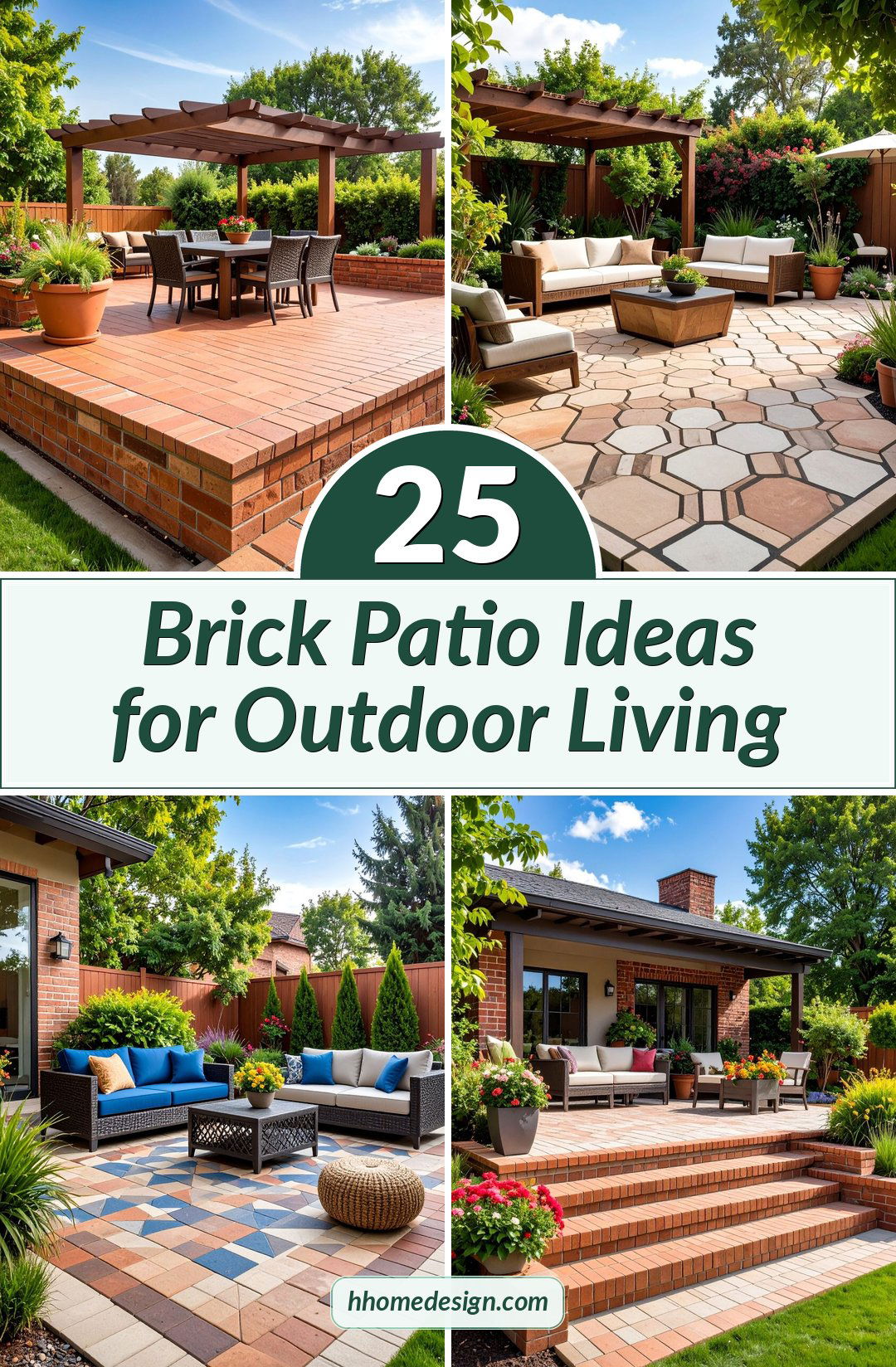
1. Classic Herringbone Brick Patio

A herringbone pattern creates visual interest through its distinctive zigzag layout that resembles fish bones. This timeless design involves placing rectangular bricks at 90-degree angles to form interlocking L-shaped pairs. The pattern can be oriented straight or diagonally at 45 degrees for different effects. Traditional red bricks work beautifully, though modern installations often feature weathered or tumbled textures for added character. The interlocking structure provides excellent stability for high-traffic areas and handles heavy furniture placement exceptionally well. Herringbone patterns suit both contemporary and traditional home styles, making them versatile choices for any outdoor setting. The visual movement created draws attention while maintaining sophisticated elegance throughout the space.
2. Modern Running Bond Brick Patio
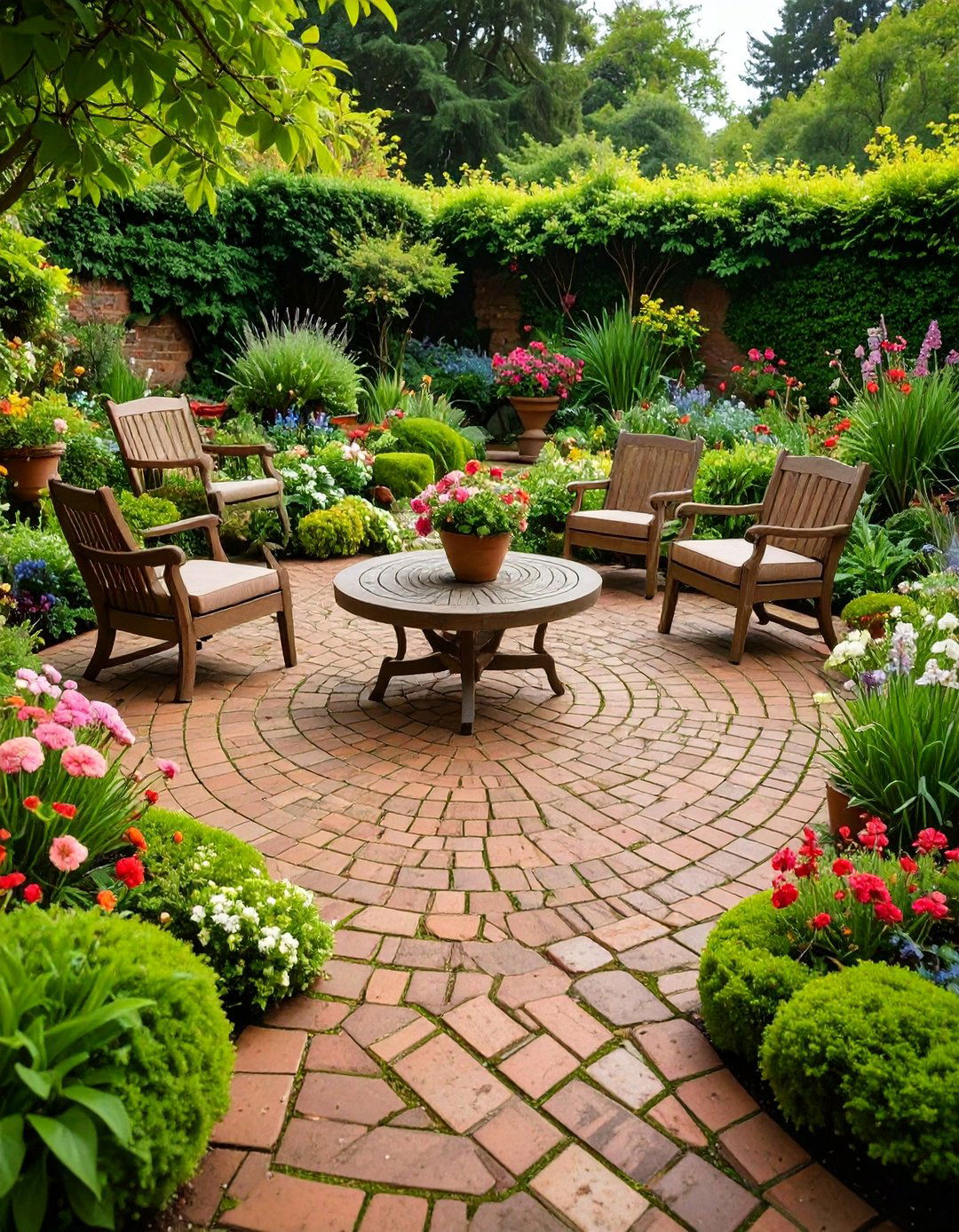
Running bond patterns offer clean, linear aesthetics perfect for contemporary outdoor designs. Each brick row staggers by half-brick lengths, creating horizontal lines that extend visual space. This pattern works exceptionally well with sleek, uniform bricks in neutral tones like charcoal, tan, or cream colors. The simplicity allows other design elements like modern furniture, planters, and lighting to take center stage. Installation proves straightforward with minimal cutting required, making it cost-effective for larger patio areas. The pattern complements minimalist landscaping and geometric garden layouts beautifully. Running bond creates seamless flow between indoor and outdoor spaces, particularly when brick colors coordinate with interior flooring materials for unified design continuity.
3. Rustic Basketweave Brick Patio
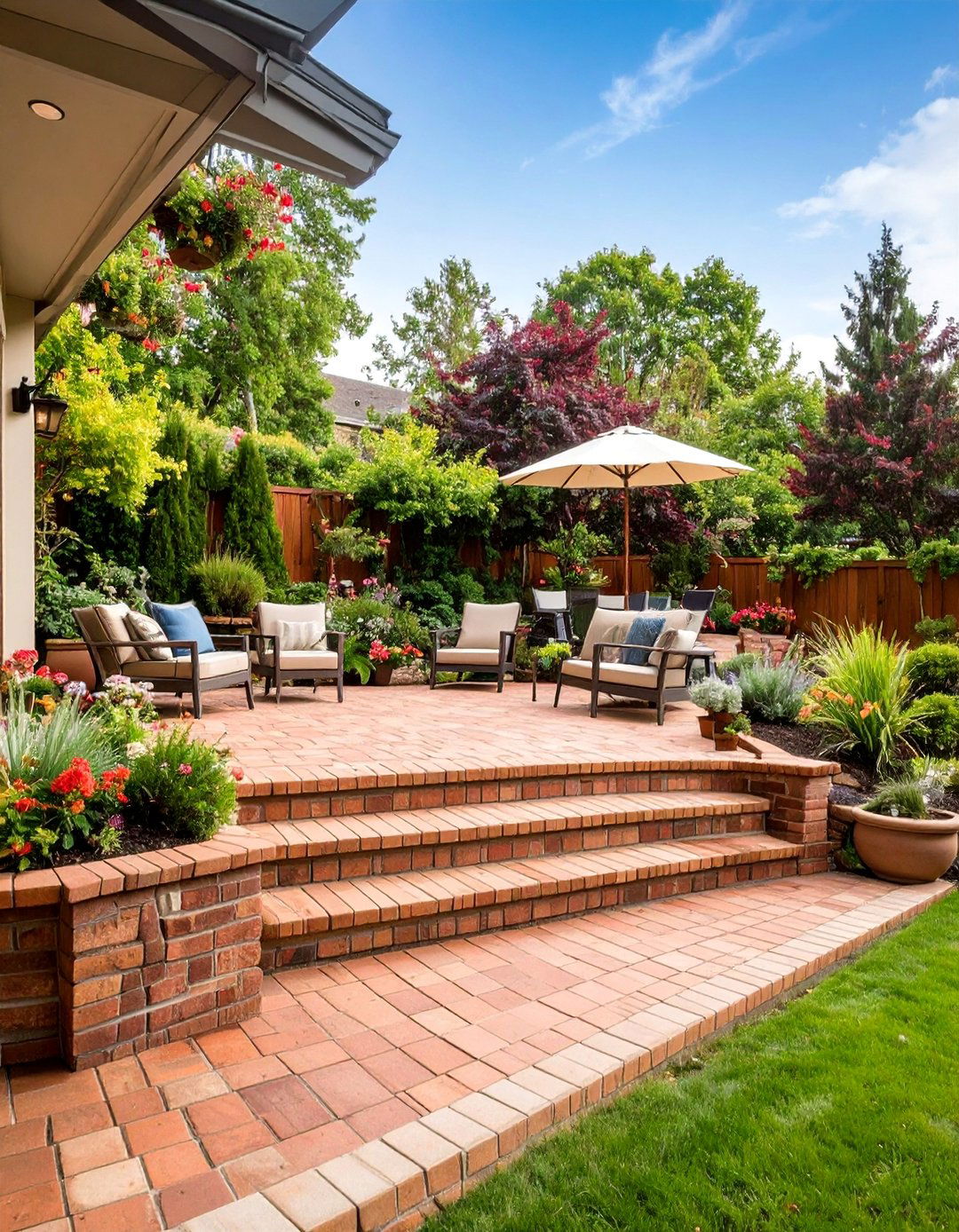
Basketweave patterns evoke traditional charm through alternating horizontal and vertical brick arrangements that mimic woven baskets. This classic design typically uses pairs of bricks laid perpendicular to create square modules throughout the patio surface. Weathered or reclaimed bricks enhance the rustic appeal with varied colors and textures. The pattern works wonderfully for cottage gardens, farmhouse styles, and traditional architecture. Different variations include single basketweave with individual bricks or double basketweave using brick pairs for larger-scale patterns. Earth-tone mortaring complements the organic feel while allowing slight irregularities that add authentic character. Basketweave patterns create comfortable, inviting spaces perfect for casual outdoor dining and relaxed entertaining in garden settings.
4. Circular Brick Patio with Fire Pit
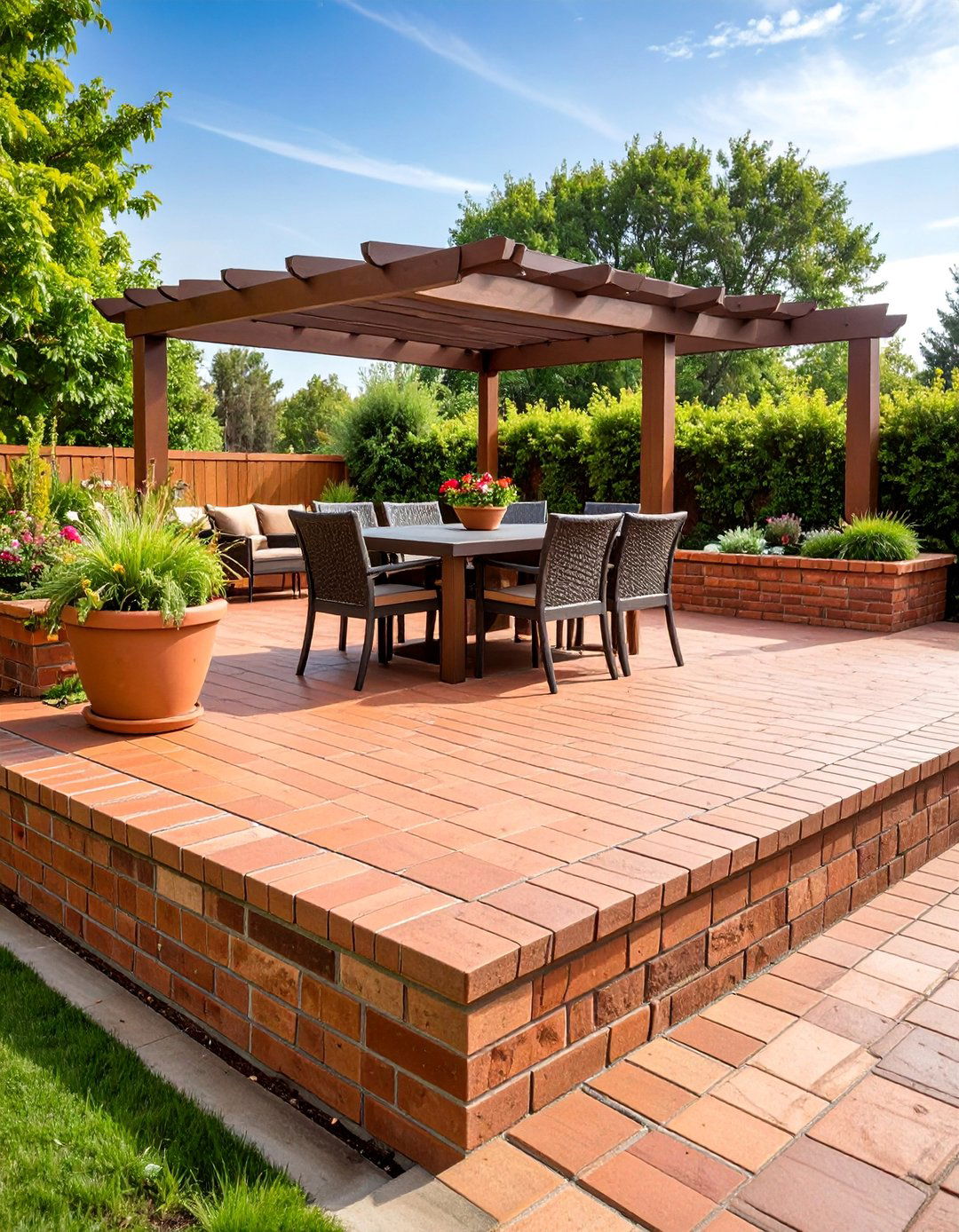
Circular brick patios create intimate gathering spaces perfect for entertaining and relaxation. The curved design naturally draws people together around central features like fire pits or water fountains. Bricks radiate outward from the center in concentric rings or fan patterns, creating dynamic visual interest. Soldier course borders define the circular edge while maintaining clean lines against surrounding landscape areas. The central fire pit becomes a natural focal point, encouraging conversation and extending outdoor season usage. Surrounding seating walls or decorative planters enhance functionality while maintaining the circular theme. This design works particularly well in smaller yards where the round shape maximizes usable space while creating dramatic impact through its geometric boldness.
5. Multi-Level Terraced Brick Patio

Multi-level brick patios transform sloped yards into functional outdoor living spaces through terraced design. Each level serves distinct purposes like dining, lounging, or cooking areas connected by brick steps or retaining walls. Consistent brick materials throughout all levels create visual unity while allowing varied patterns on different tiers. The elevation changes add dimension and create natural privacy zones within the outdoor space. Retaining walls prevent erosion while providing additional seating and planting opportunities. Different brick patterns on each level add interest without overwhelming the overall design. This approach maximizes usable space on challenging terrain while creating sophisticated outdoor rooms that flow naturally from one activity area to another.
6. Raised Brick Platform Patio

Raised brick patios create elevated outdoor rooms with improved drainage and enhanced views of surrounding landscapes. The platform design typically sits 12-24 inches above ground level, providing natural definition from lawn and garden areas. Brick retaining walls support the elevated surface while creating integrated seating opportunities around the perimeter. This elevation improves sightlines for entertaining and creates sense of importance for the outdoor space. Drainage benefits include better water management and reduced moisture issues compared to ground-level installations. The raised design accommodates under-patio storage or utilities while maintaining attractive appearance. Built-in planters and lighting can be integrated into retaining walls for enhanced functionality and evening ambiance.
7. Brick Patio with Integrated Outdoor Kitchen
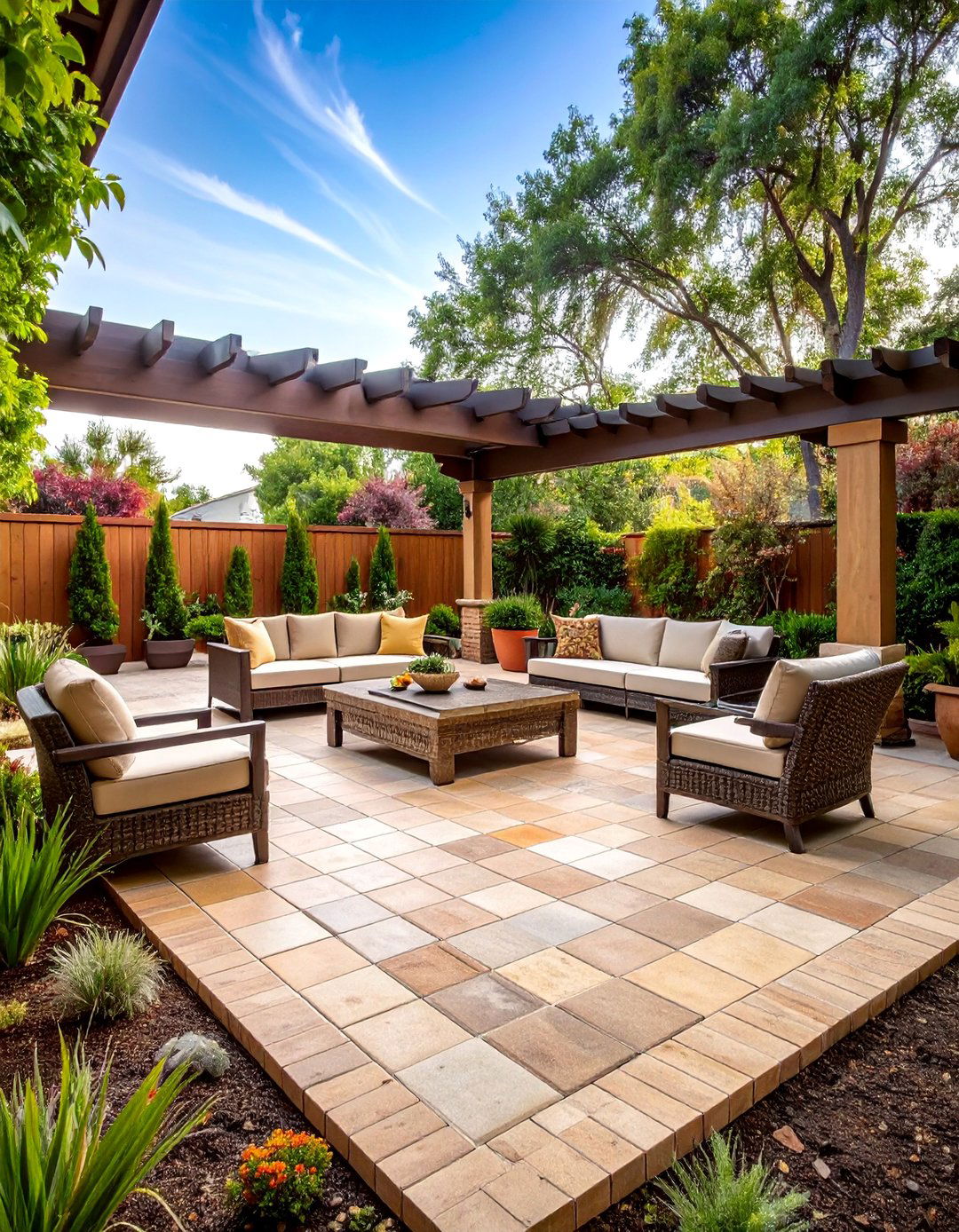
Outdoor kitchen integration transforms brick patios into comprehensive cooking and entertainment zones. Brick construction extends from patio surface to built-in grilling stations, pizza ovens, and prep counters for unified design. Heat-resistant fire bricks near cooking areas ensure safety while maintaining aesthetic continuity. Counter surfaces can incorporate natural stone or concrete tops while maintaining brick base construction. Storage areas, refrigeration units, and sinks integrate seamlessly into brick structures. The durable brick construction withstands cooking heat and weather exposure while requiring minimal maintenance. Proper ventilation and utility connections ensure functionality while brick archways and decorative details add architectural interest. This comprehensive approach creates restaurant-quality outdoor cooking experiences within residential settings.
8. Geometric Diamond Pattern Brick Patio

Diamond patterns create sophisticated geometric interest through diagonal brick arrangements that form repeating diamond shapes. This contemporary design approach uses contrasting brick colors or textures to emphasize the geometric pattern. Each diamond module typically measures 24-36 inches across, creating human-scale pattern repetition. The angular design complements modern architecture while adding visual complexity to outdoor spaces. Border treatments frame the geometric pattern while transitioning to surrounding landscape areas. This pattern requires precise installation and cutting for clean pattern execution. The result creates striking visual impact that works particularly well with contemporary furniture and minimalist landscaping. Diamond patterns suit larger patio areas where the geometric repetition can be fully appreciated.
9. Traditional English Bond Brick Patio

English bond patterns alternate rows of headers and stretchers, creating sophisticated traditional designs reminiscent of historic architecture. Header rows show brick ends while stretcher rows display brick lengths, creating varied texture and visual rhythm. This pattern often incorporates contrasting header bricks in darker colors for enhanced pattern definition. The alternating arrangement provides excellent structural integrity while creating refined appearance suitable for formal garden settings. Traditional red bricks work beautifully, though contemporary installations might use gray or brown tones for updated aesthetics. The pattern complexity requires skilled installation but results in distinctive, high-end appearance. English bond suits period homes and formal landscape designs where architectural authenticity enhances overall property character.
10. Curved Serpentine Brick Patio

Serpentine curves create flowing, organic patio designs that complement natural landscape features and garden plantings. The curved edges follow gentle S-shaped or wave-like patterns rather than rigid geometric lines. Flexible brick cutting and careful planning ensure smooth curve execution without awkward transitions or gaps. This design approach works beautifully around existing trees, rock formations, or sloped terrain where straight lines would appear forced. Curved borders can incorporate integrated planters or seating areas that follow the flowing design theme. The organic shapes create intimate spaces while maintaining generous circulation areas. Serpentine designs require more complex installation but reward with unique character that distinguishes the space from typical rectangular patio layouts.
11. Brick and Stone Combination Patio
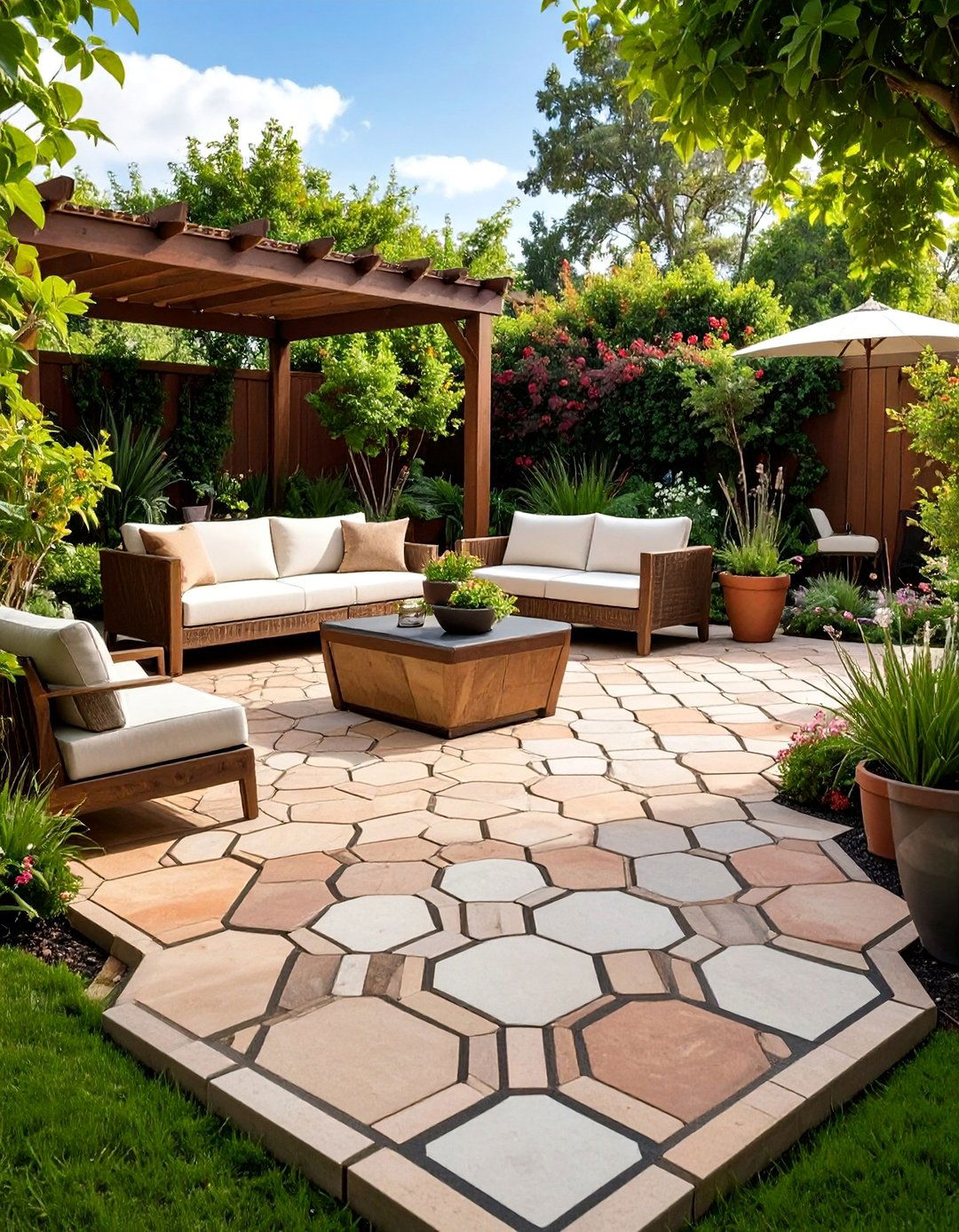
Combining bricks with natural stone creates textural contrast and visual interest through material variety. Stone sections might feature flagstone, bluestone, or limestone panels bordered by brick courses or patterns. The material combination allows zoning different activity areas while maintaining design continuity. Brick borders can frame stone dining areas or accent particular zones within larger patio spaces. Color coordination ensures materials complement rather than compete, typically using earth tones that harmonize naturally. The mixed materials add durability variety and can accommodate different budget requirements across the patio area. Maintenance varies by material but both stone and brick offer long-term durability. This approach creates sophisticated, custom appearance that elevates ordinary outdoor spaces.
12. Victorian-Style Ornate Brick Patio
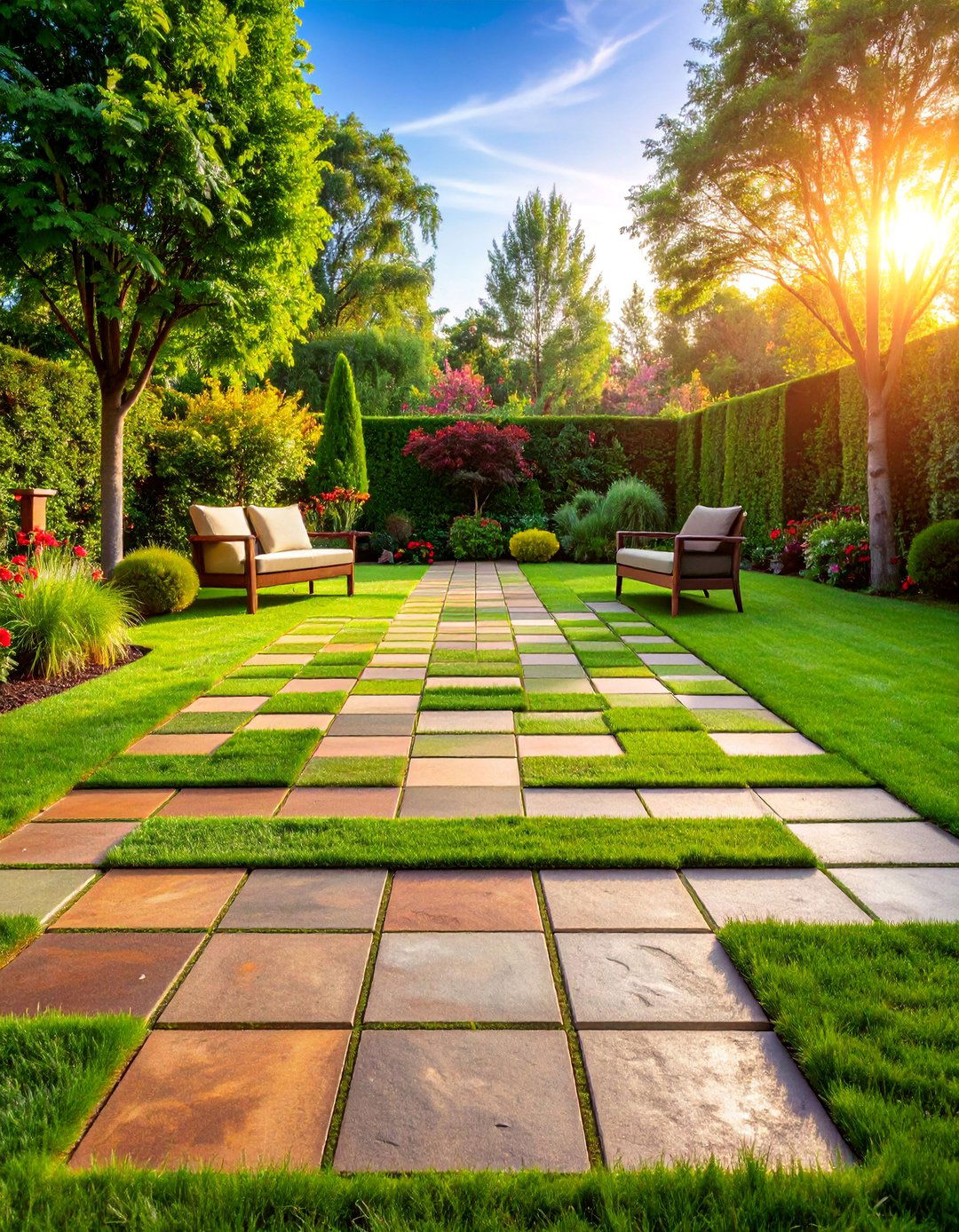
Victorian-inspired designs incorporate decorative brick patterns, borders, and architectural details reminiscent of 19th-century craftsmanship. Ornate patterns might include Celtic knots, floral motifs, or geometric medallions created through careful brick placement and contrasting colors. Decorative borders frame the main patio area while corner details and center medallions add focal points. Period-appropriate brick colors include deep reds, browns, and buff tones that complement Victorian architecture. Intricate patterns require master craftsmanship and detailed planning for proper execution. The ornate approach suits historic homes and formal garden settings where elaborate detail enhances rather than overwhelms the environment. Victorian patterns create conversation pieces while providing durable, functional outdoor surfaces.
13. Minimalist Stack Bond Brick Patio
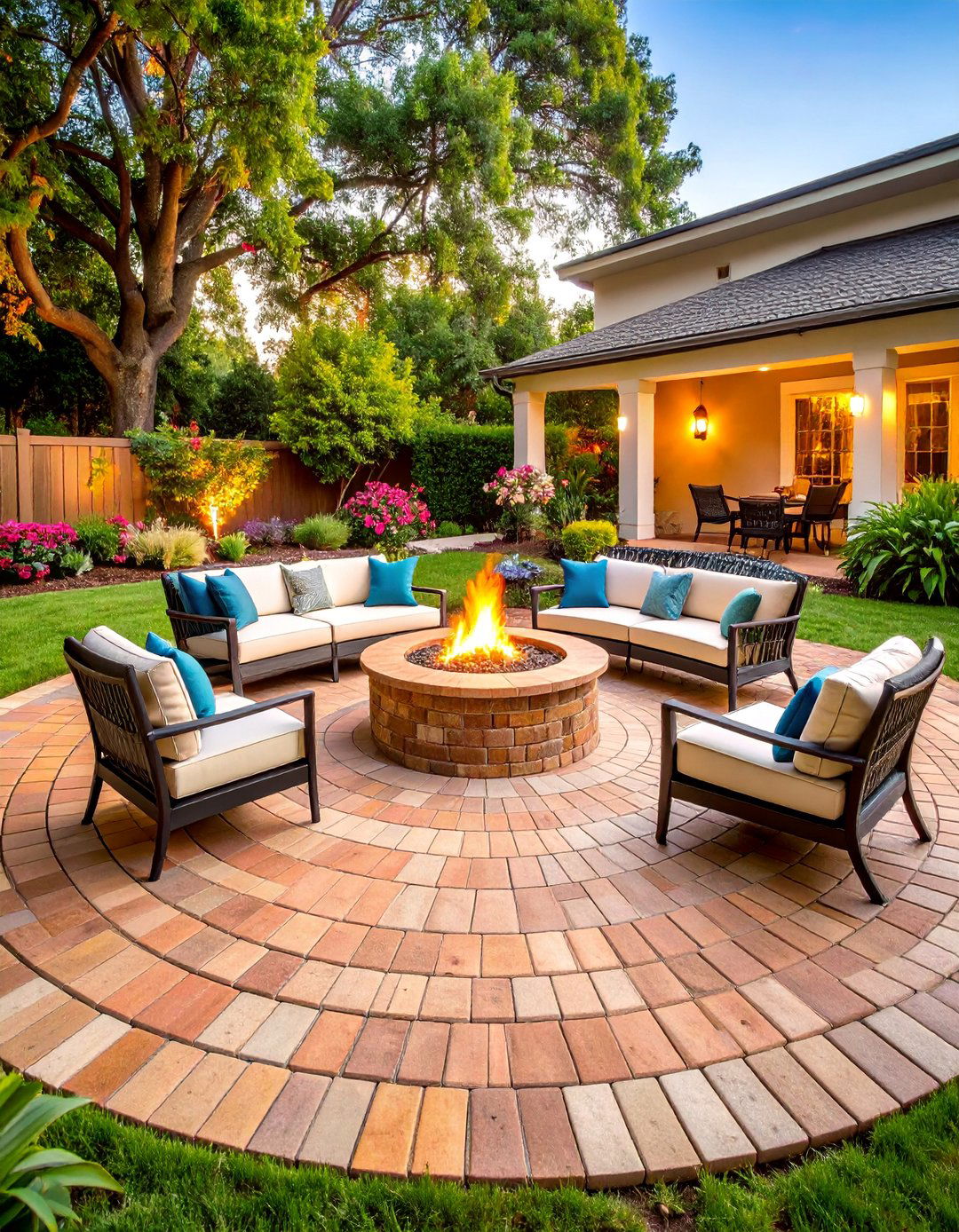
Stack bond patterns arrange bricks in perfect grid alignment, creating clean, contemporary aesthetics through geometric precision. Unlike running bond, stack bond maintains continuous joint lines both horizontally and vertically for crisp, modern appearance. This pattern works exceptionally well with uniform, precision-cut bricks in neutral colors like gray, tan, or white. The grid-like arrangement complements minimalist architecture and contemporary landscape design. Stack bond requires careful installation to maintain perfect alignment, but results in sophisticated, uncluttered appearance. The pattern provides excellent backdrop for modern outdoor furniture and architectural planters. This approach emphasizes spatial clarity and geometric order, making it ideal for urban settings and contemporary home styles where simplicity and precision are valued.
14. Tumbled Brick Cottage Garden Patio

Tumbled bricks create relaxed, cottage-style patios with weathered appearance and slightly irregular edges that enhance rustic charm. The manufacturing process gives bricks rounded corners and varied surfaces that suggest age and authentic character. Informal laying patterns allow slight variations in joint widths and brick placement for organic feel. Earth-tone mortaring complements the weathered brick appearance while accommodating natural irregularities. This style works beautifully with cottage gardens, herb plantings, and informal landscape designs. The relaxed approach encourages climbing plants, moss growth, and natural aging that enhances character over time. Tumbled brick patios create comfortable, lived-in feeling perfect for casual outdoor living and garden party entertaining.
15. Pinwheel Pattern Brick Patio
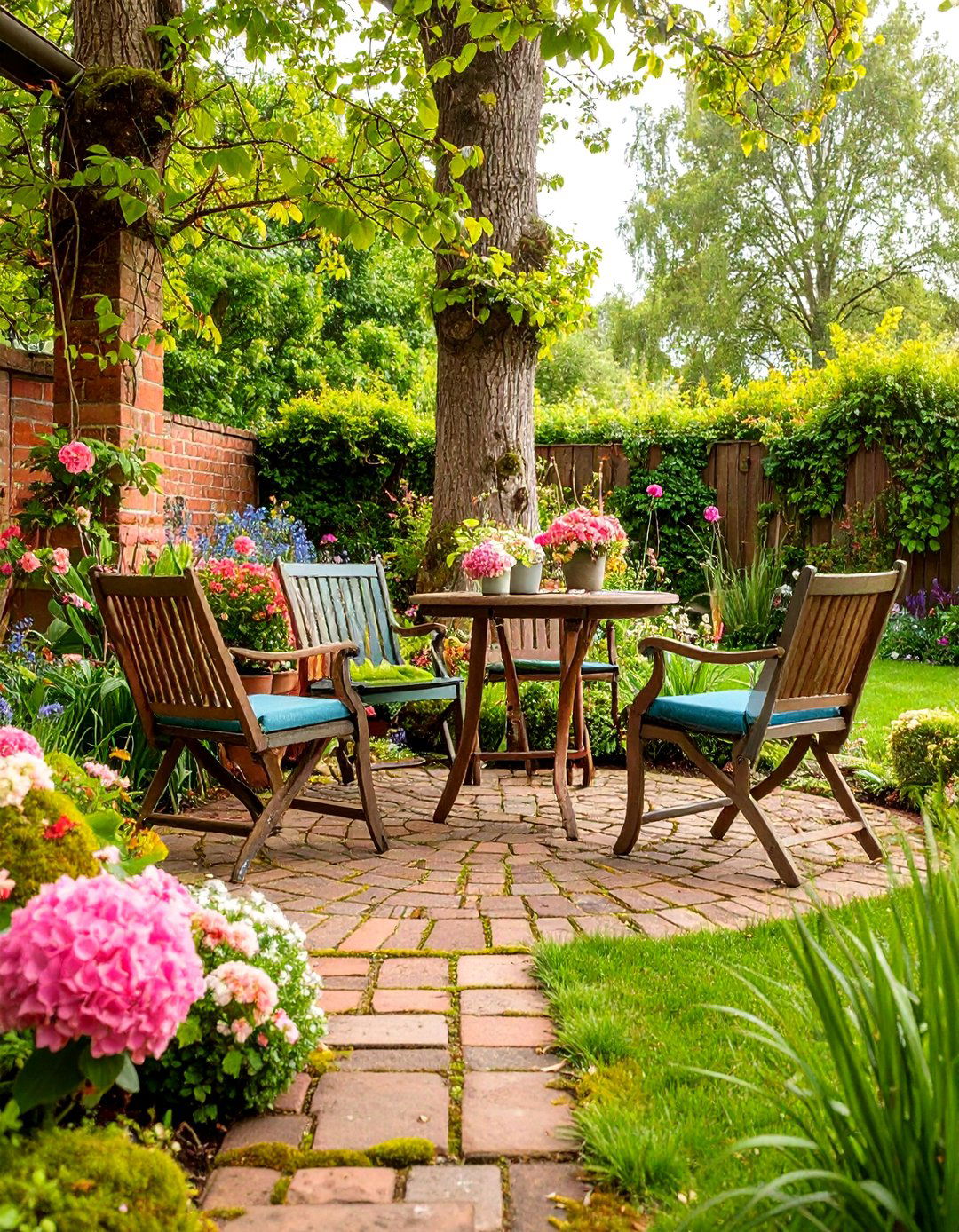
Pinwheel patterns create dynamic visual interest through square modules featuring four bricks arranged around central half-bricks. Each pinwheel unit rotates the directional arrangement, creating spinning visual effects across the patio surface. The pattern requires precise cutting for center bricks but rewards with distinctive, artistic appearance. Contrasting colors for center bricks enhance the pinwheel effect and create focal points throughout the pattern. This design approach suits areas where artistic expression and visual complexity are desired over simple functionality. The modular nature allows easy repairs and pattern modifications as needed. Pinwheel patterns work well with both traditional and contemporary settings, depending on brick colors and surrounding landscape design elements.
16. Brick Patio with Integrated Water Feature

Water features integrated into brick patios create serene focal points while adding cooling effects and ambient sound. Design options include fountains, reflecting pools, or stream channels that flow through or around brick seating areas. Brick construction can incorporate water-resistant mortaring and proper drainage systems for long-term durability. The hard brick surfaces complement soft water elements through textural contrast and material variety. Surrounding brick seating or planting areas enhance the water feature's impact while providing comfortable viewing positions. Underwater lighting extends enjoyment into evening hours while creating dramatic visual effects. Proper circulation systems ensure water quality while minimizing maintenance requirements. This combination creates resort-like atmospheres perfect for relaxation and meditation.
17. Hexagonal Brick Patio Design
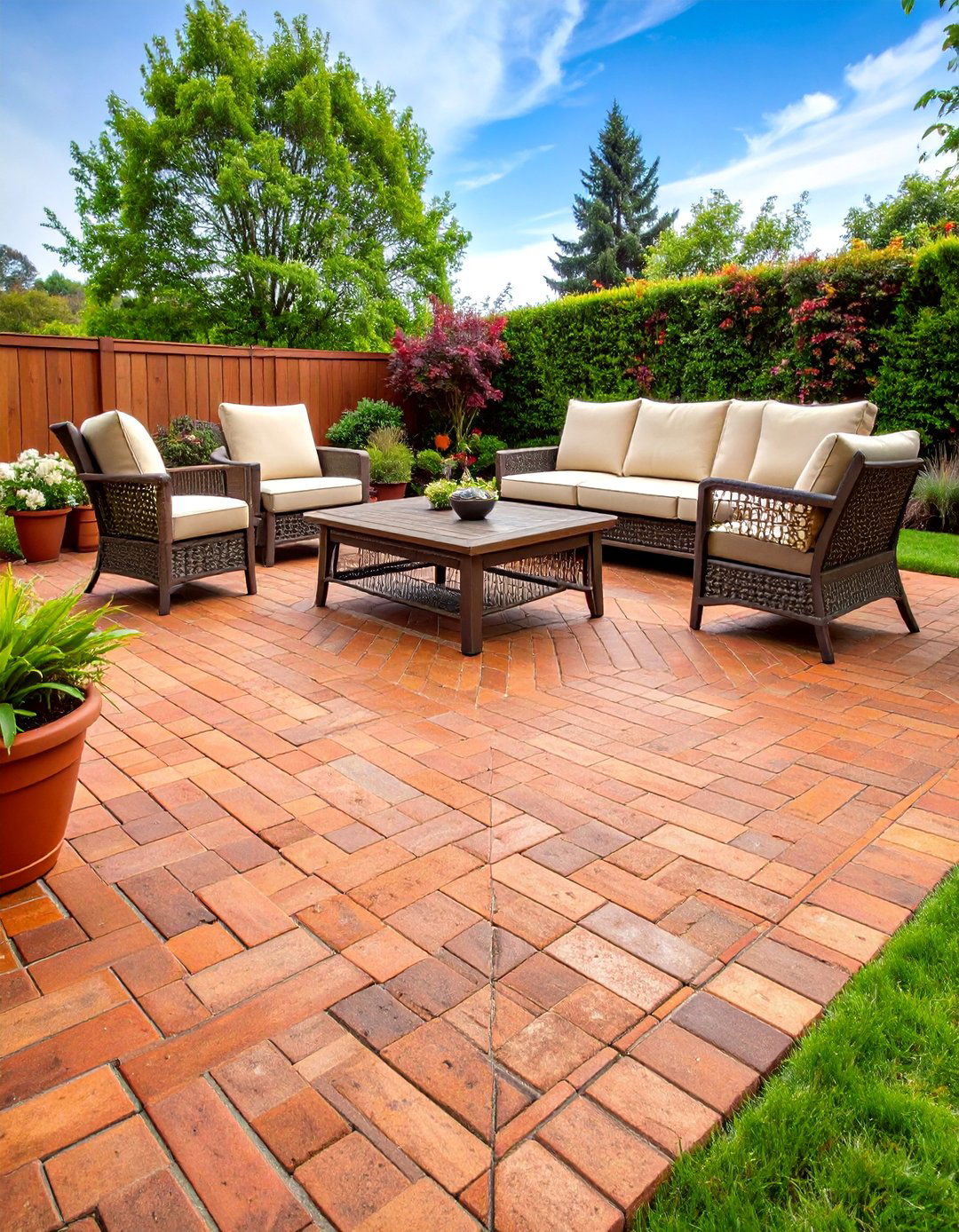
Hexagonal brick arrangements create honeycomb-like patterns that offer unique geometric interest and efficient space utilization. Special hexagonal bricks or creative cutting of standard bricks achieves this distinctive pattern. The six-sided modules fit together efficiently while creating complex visual textures across the patio surface. Border treatments require careful planning to transition from hexagonal patterns to straight patio edges. This pattern works particularly well for smaller, intimate patio spaces where the geometric complexity can be fully appreciated. The honeycomb effect creates organic feeling despite geometric precision, making it suitable for both contemporary and natural landscape settings. Installation complexity requires skilled craftsmanship but results in distinctive character that sets the space apart from conventional patio designs.
18. Checkerboard Brick and Grass Patio
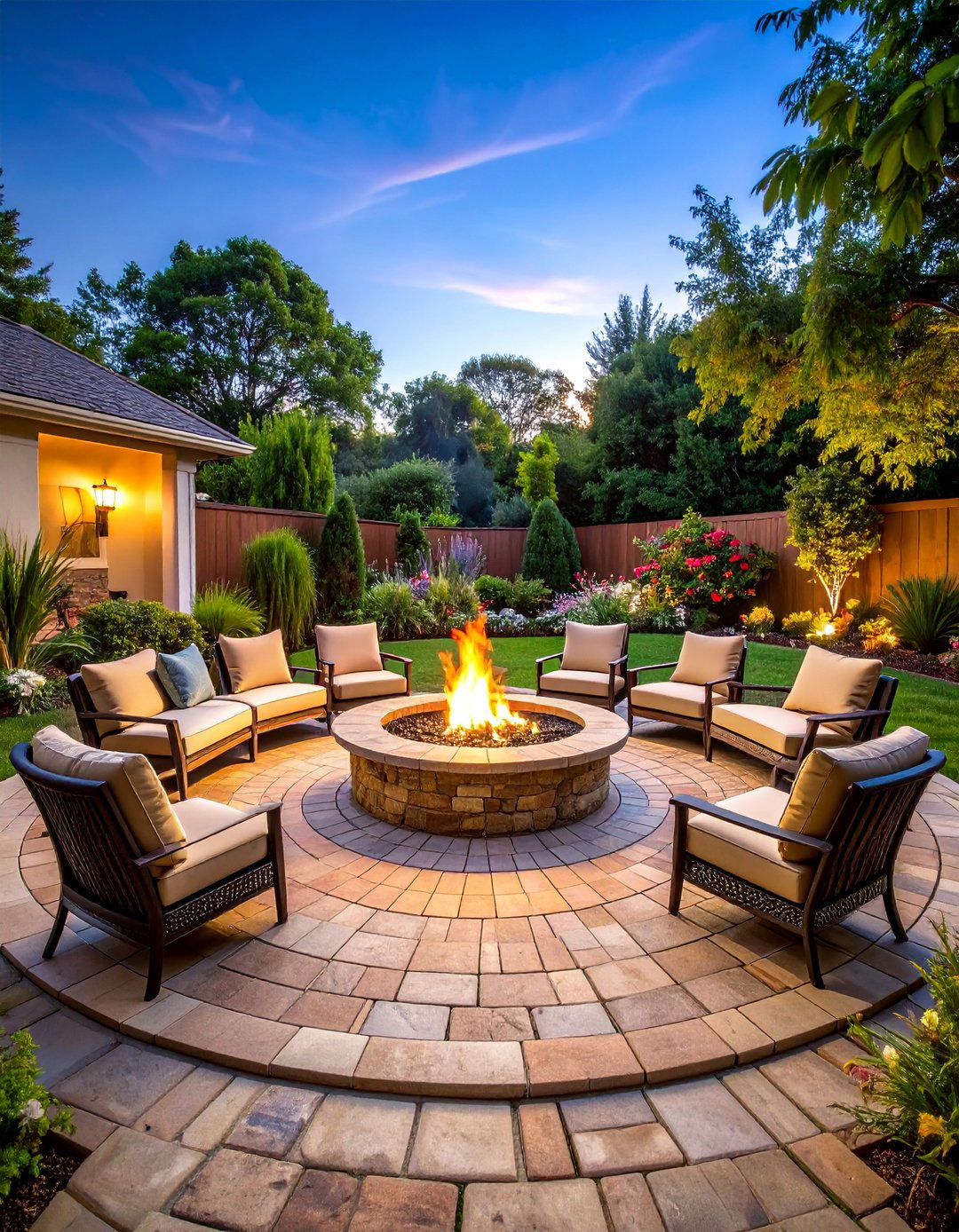
Checkerboard patterns alternate brick squares with grass or groundcover sections, creating living tapestry effects that blend hardscape and landscape elements. Each module typically measures 18-24 inches square, allowing adequate growing space for grass while maintaining walking surfaces. The pattern requires careful edge details to contain soil and prevent grass encroachment into brick areas. Drainage considerations ensure proper water management for both brick and planted areas. This design approach reduces overall brick requirements while creating environmentally friendly surfaces that manage stormwater naturally. The living elements provide seasonal color changes and soften the hard patio surfaces. Maintenance includes both brick cleaning and grass care, but results in unique, sustainable outdoor flooring that adapts to environmental conditions.
19. Mortared Brick Patio with Decorative Joints
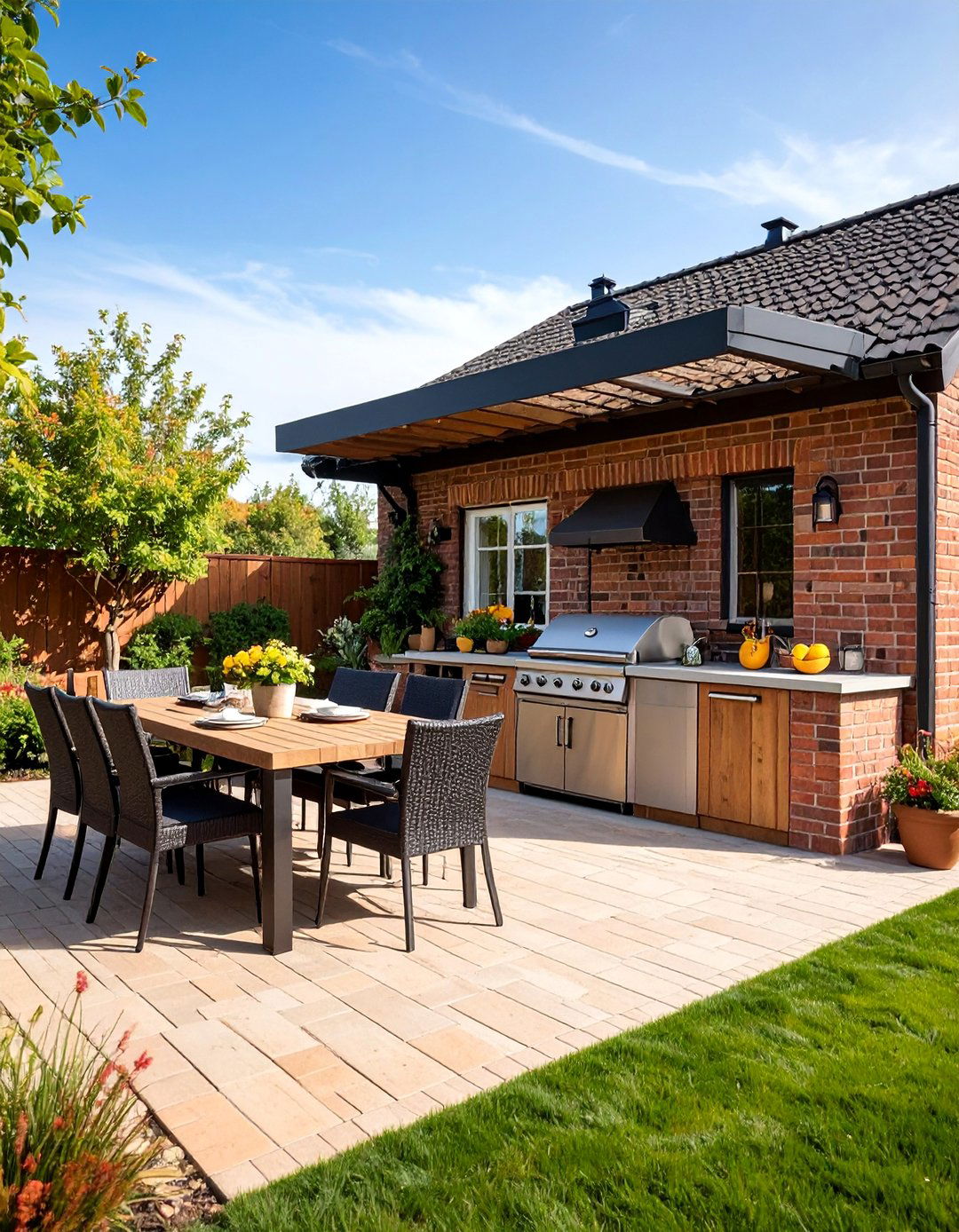
Decorative mortar joints elevate simple brick patterns through colored, textured, or raised joint treatments that become design features themselves. Options include contrasting mortar colors, struck joints that create shadow lines, or raised joints that emphasize pattern geometry. Colored mortars can complement or contrast brick colors for enhanced visual impact. Joint finishing techniques include smooth, raked, or tooled surfaces that add textural variety. This approach allows simple brick patterns to achieve sophisticated appearance through joint treatment rather than complex laying patterns. The technique works with any brick color or pattern while providing opportunities for personalization and artistic expression. Proper mortar selection ensures durability while maintaining decorative appearance through weather exposure and seasonal changes.
20. Radial Spoke Brick Patio
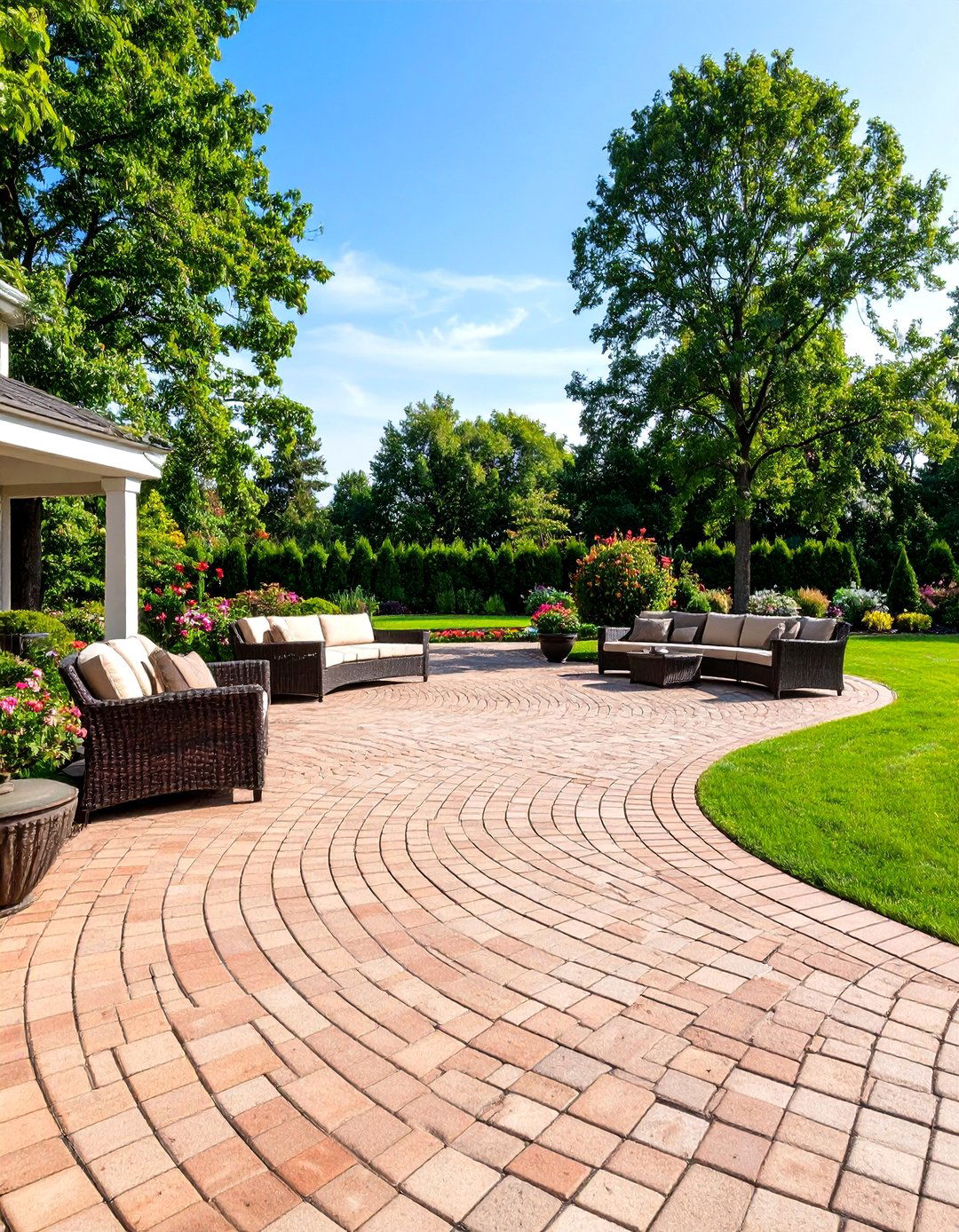
Radial patterns arrange bricks like wheel spokes emanating from central points, creating dynamic designs perfect for circular or oval patio shapes. The spoke arrangement can focus on single centers or multiple focal points throughout the patio area. Central features like fire pits, fountains, or decorative medallions anchor the radial design while bricks extend outward in straight or gently curved lines. This pattern creates strong directional movement that draws attention to central features while providing natural traffic flow patterns. Border treatments contain the radial pattern while transitioning to surrounding landscape areas. The dramatic geometry suits formal garden settings and architectural contexts where bold pattern statements enhance overall design impact.
21. Split-Level Brick Patio with Steps
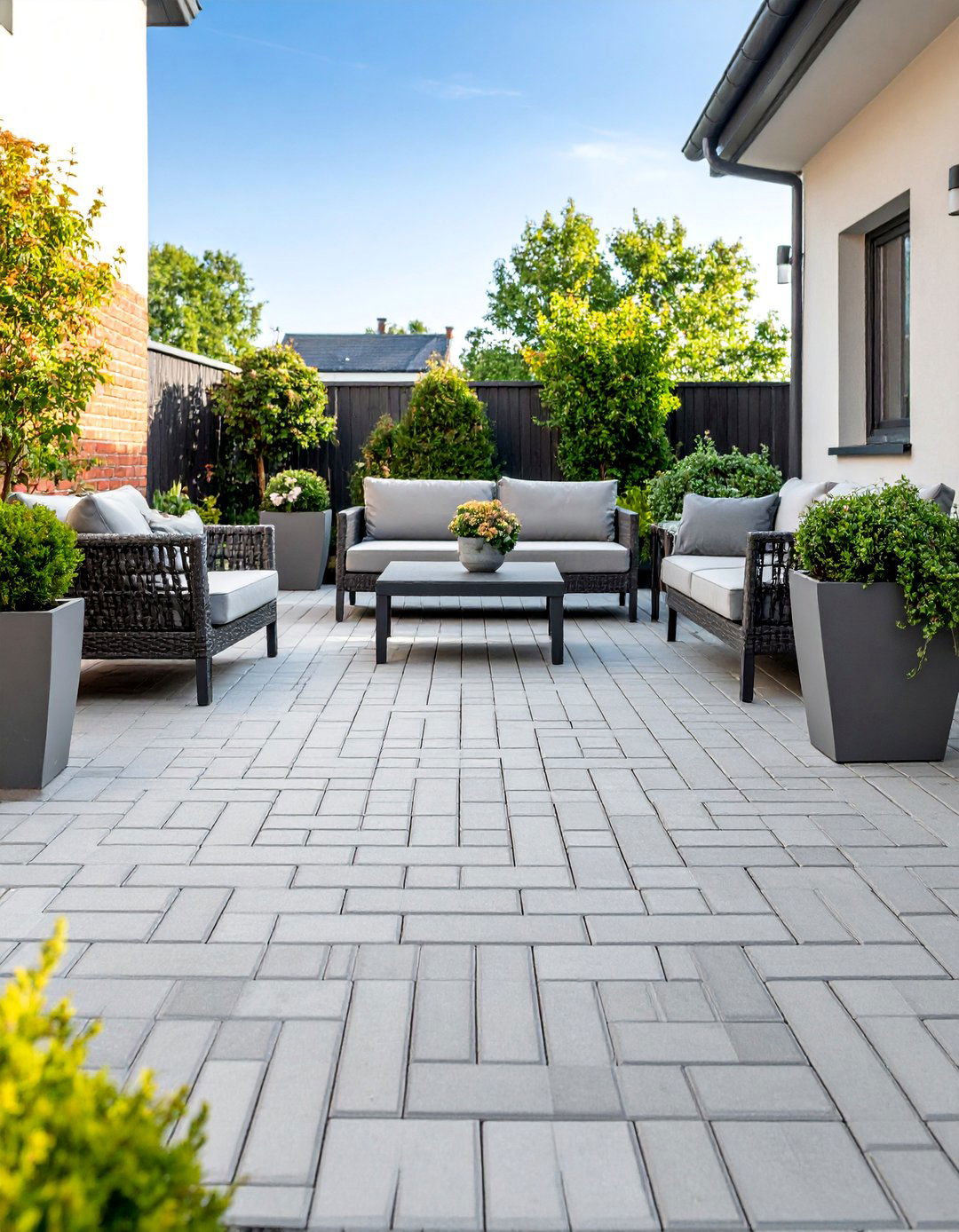
Split-level designs create distinct zones through elevation changes connected by integrated brick steps and retaining walls. Upper levels might accommodate dining areas while lower sections provide conversation or fire pit zones. Consistent brick materials throughout all levels maintain visual unity while allowing functional separation. Step construction requires careful attention to rise and run dimensions for safe, comfortable use. Integrated lighting in steps enhances safety while creating dramatic evening effects. The level changes provide natural privacy screening and help manage sloped sites effectively. Retaining walls offer additional seating and planting opportunities while preventing erosion. This approach maximizes functionality on challenging terrain while creating sophisticated outdoor room arrangements.
22. Border-Framed Brick Patio
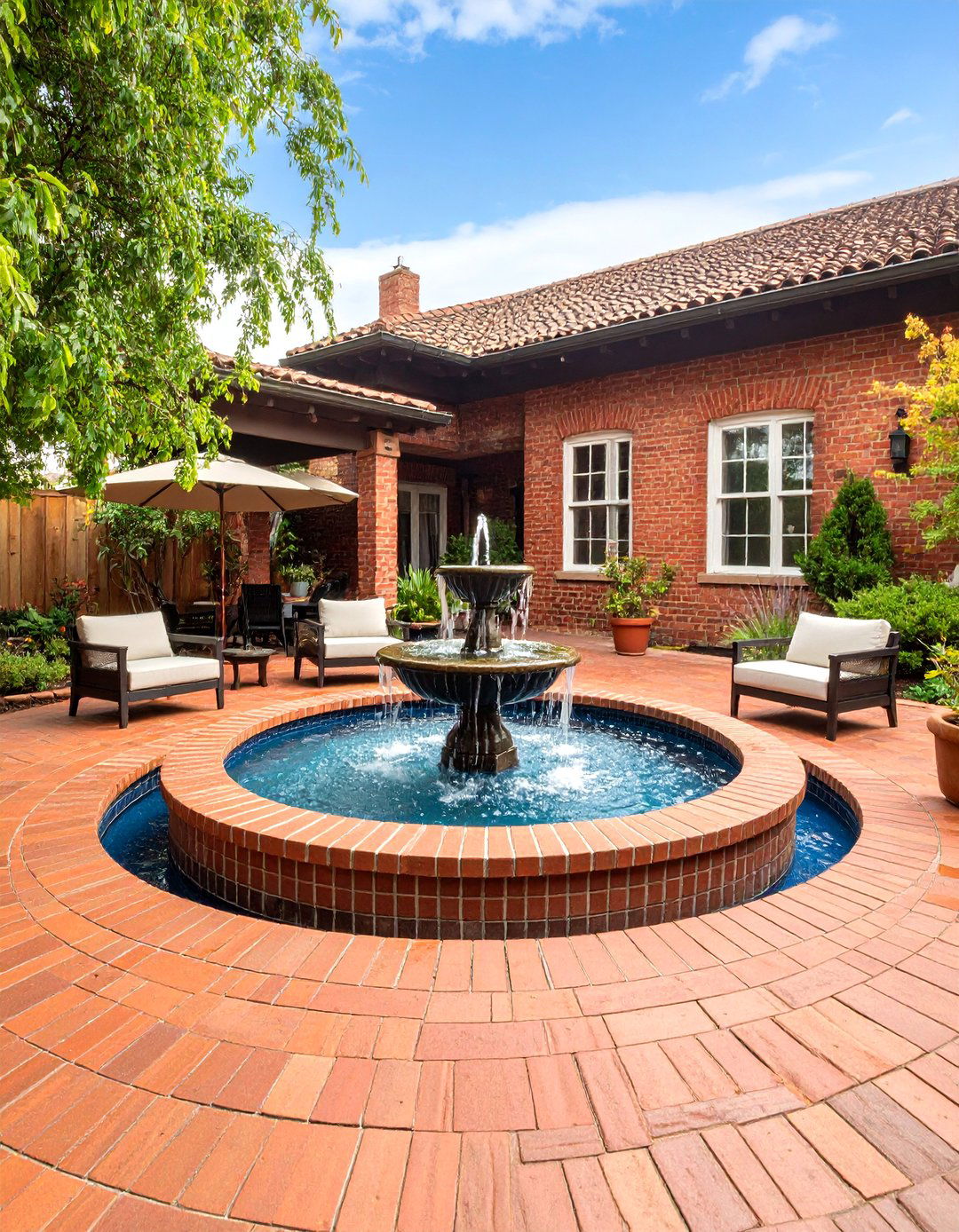
Decorative borders frame main patio areas while adding visual definition and architectural detail to outdoor spaces. Border treatments might include soldier courses, decorative patterns, or contrasting brick colors that distinguish edge areas from main patio surfaces. The framing effect creates importance for the patio area while providing transition zones to surrounding landscape elements. Border widths typically range from single courses to 18-inch bands, depending on patio scale and desired visual impact. Corner details require special attention to maintain pattern continuity and professional appearance. This approach works with any main patio pattern while adding refinement and architectural character that enhances property values and outdoor living experiences.
23. Aged Brick Patio with Moss Accents

Aged brick patios embrace natural weathering and moss growth for authentic, lived-in character that improves with time. Reclaimed or artificially aged bricks provide starting character while allowing natural moss and lichen establishment in joint areas. Wide mortar joints accommodate plant growth while maintaining structural integrity and drainage function. The aging process creates unique patina and color variation that cannot be artificially replicated. This approach suits shaded areas and humid climates where moss growth occurs naturally. Maintenance involves occasional cleaning while preserving desired aging effects and plant growth. The result creates romantic, European-inspired atmospheres perfect for intimate dining and contemplative garden settings.
24. Contemporary Linear Brick Patio
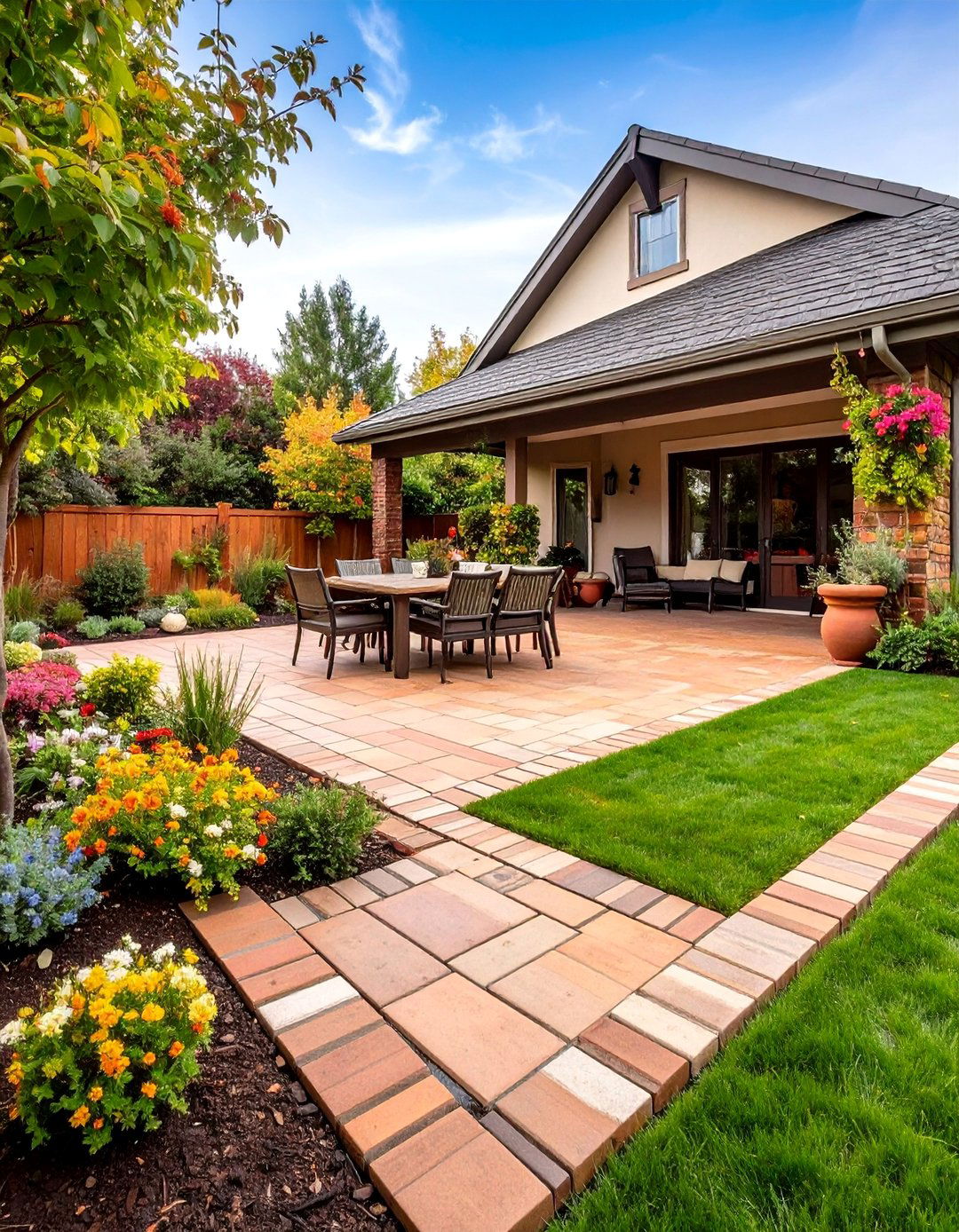
Linear arrangements emphasize length and direction through parallel brick courses that create strong visual lines across patio surfaces. This contemporary approach works particularly well for rectangular patios and modern architectural settings. Brick orientation can run parallel or perpendicular to building lines, depending on desired visual effects and spatial proportions. Minimal joint lines and precision installation create clean, sophisticated appearance that complements contemporary landscape design. The linear emphasis works well with geometric planters, water features, and modern outdoor furniture arrangements. Color selection typically favors neutral tones that coordinate with contemporary architectural palettes. This pattern provides excellent backdrop for outdoor art installations and architectural lighting while maintaining functional durability for outdoor living activities.
25. Mixed-Size Brick Patio Pattern
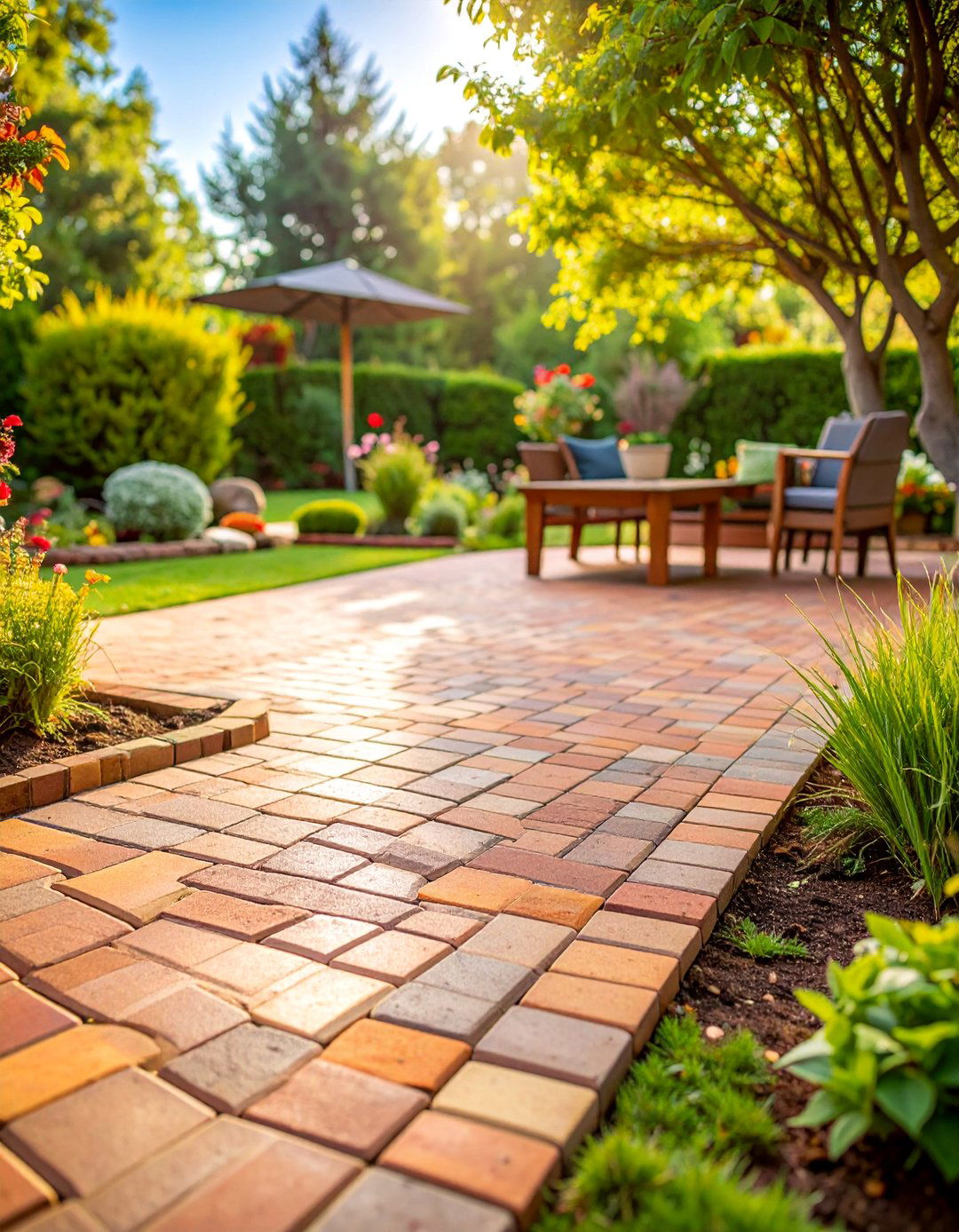
Mixed-size patterns combine different brick dimensions to create complex, custom designs that avoid monotonous repetition. Standard bricks might combine with half-size units, squares, or specially sized pieces for unique pattern development. The size variation adds visual texture and allows creative pattern arrangements impossible with uniform brick sizes. Color coordination ensures pattern unity while size variation provides textural interest and artistic complexity. This approach allows personalization and artistic expression while maintaining functional patio surfaces. Pattern planning requires careful attention to proportions and transitions for professional appearance. The mixed-size approach creates distinctive character that reflects personal style while providing conversation pieces and unique outdoor environments that stand apart from conventional patio installations.
Conclusion:
Brick patios offer timeless beauty and exceptional versatility for creating outstanding outdoor living spaces. From classic herringbone and basketweave patterns to contemporary geometric designs, each approach provides unique character while delivering lasting durability. The 25 ideas presented showcase how creative pattern arrangements, material combinations, and thoughtful design features transform ordinary outdoor areas into extraordinary gathering spaces. Current 2025 trends emphasize sustainability, natural textures, and seamless indoor-outdoor integration, making brick an ideal choice for modern outdoor living. Whether pursuing traditional charm or contemporary sophistication, these comprehensive design approaches ensure your brick patio becomes a valued centerpiece that enhances both property value and lifestyle enjoyment.


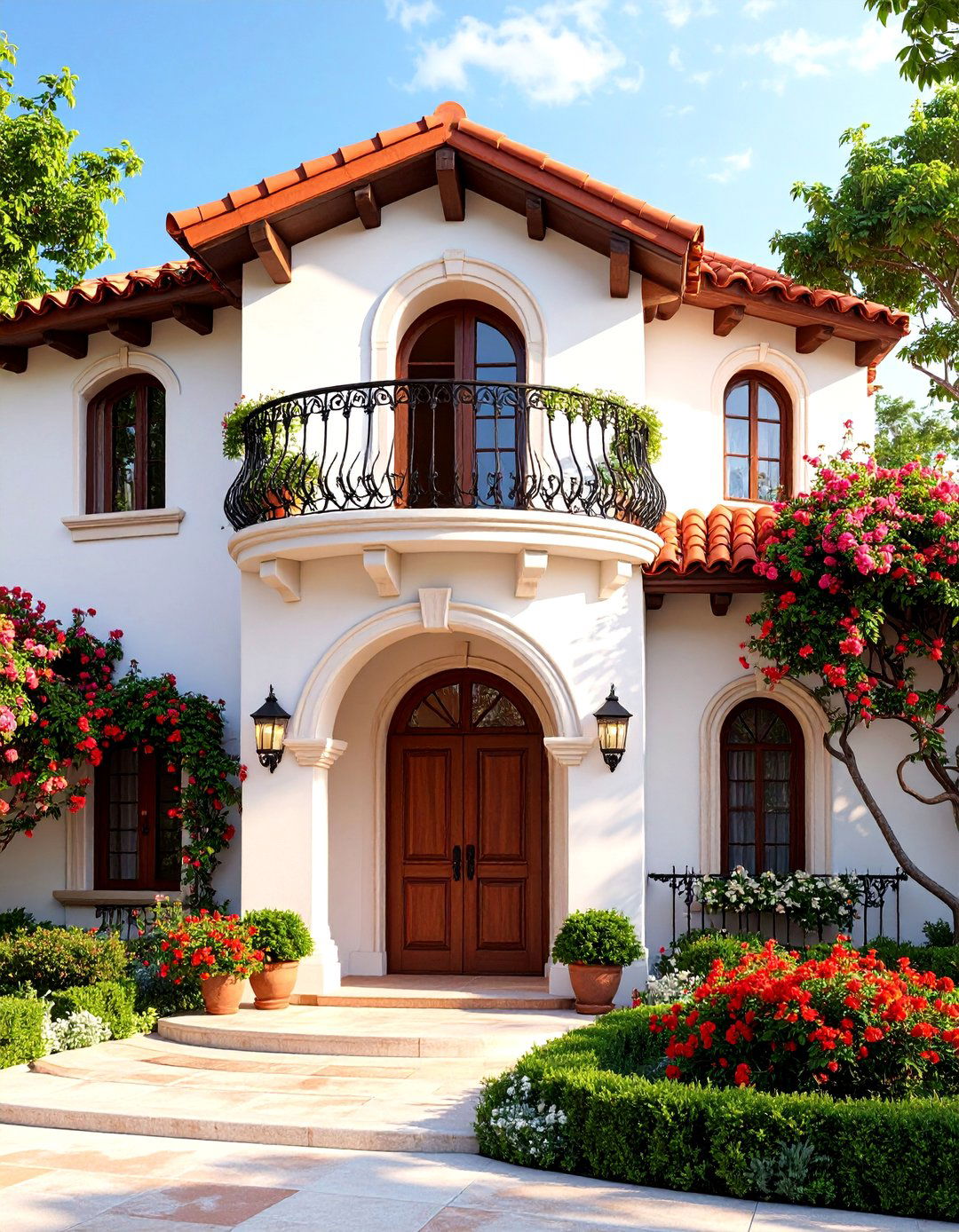
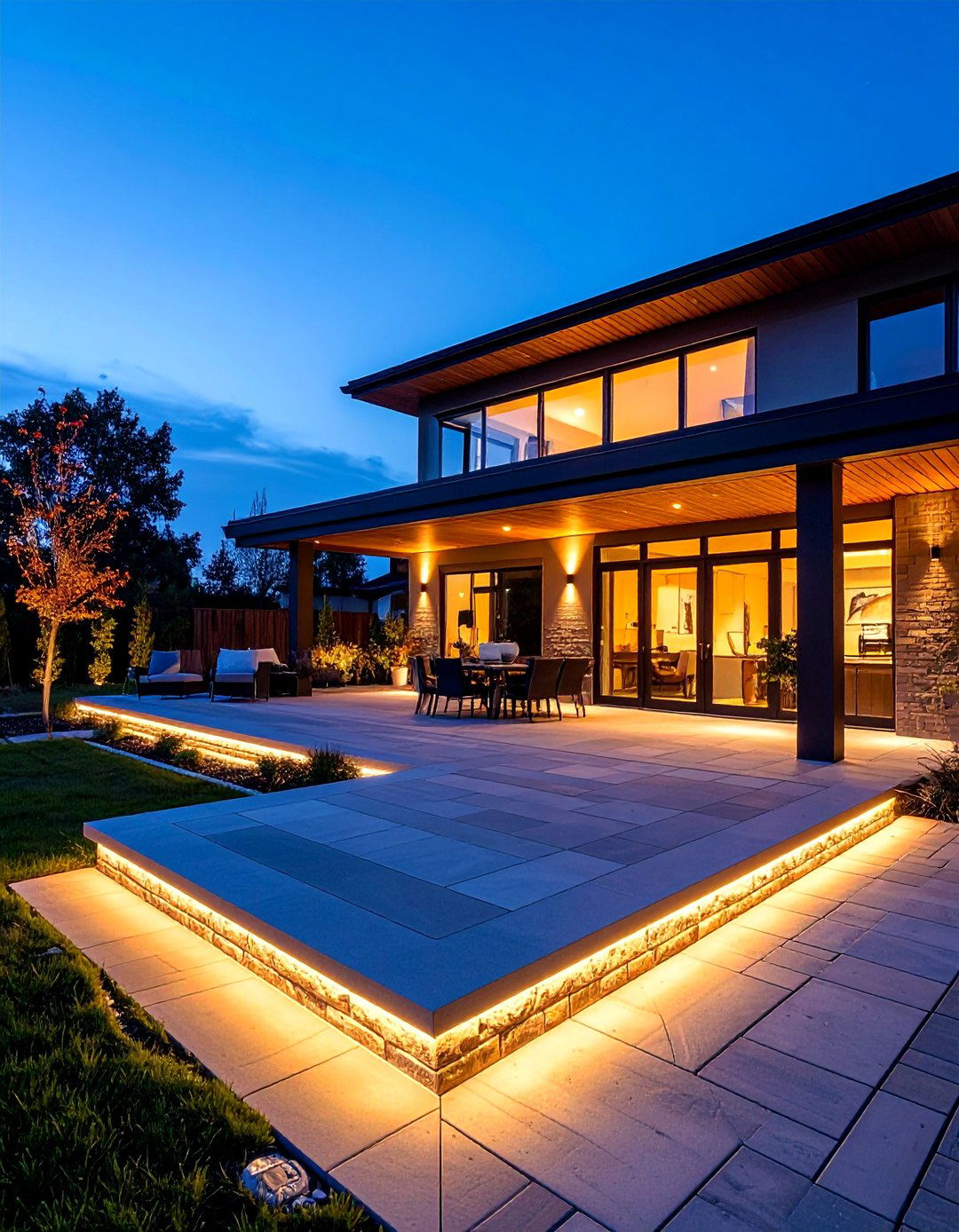


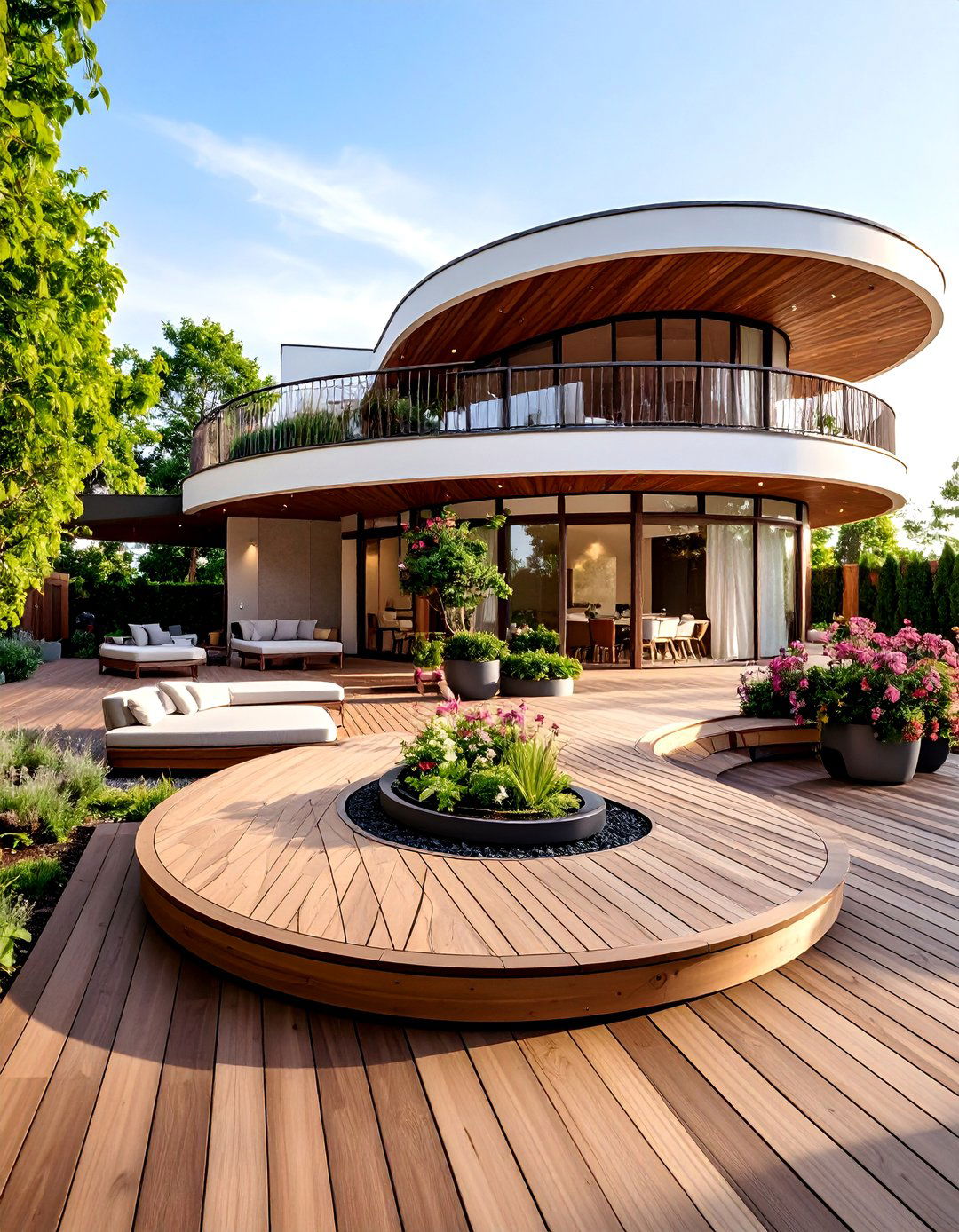

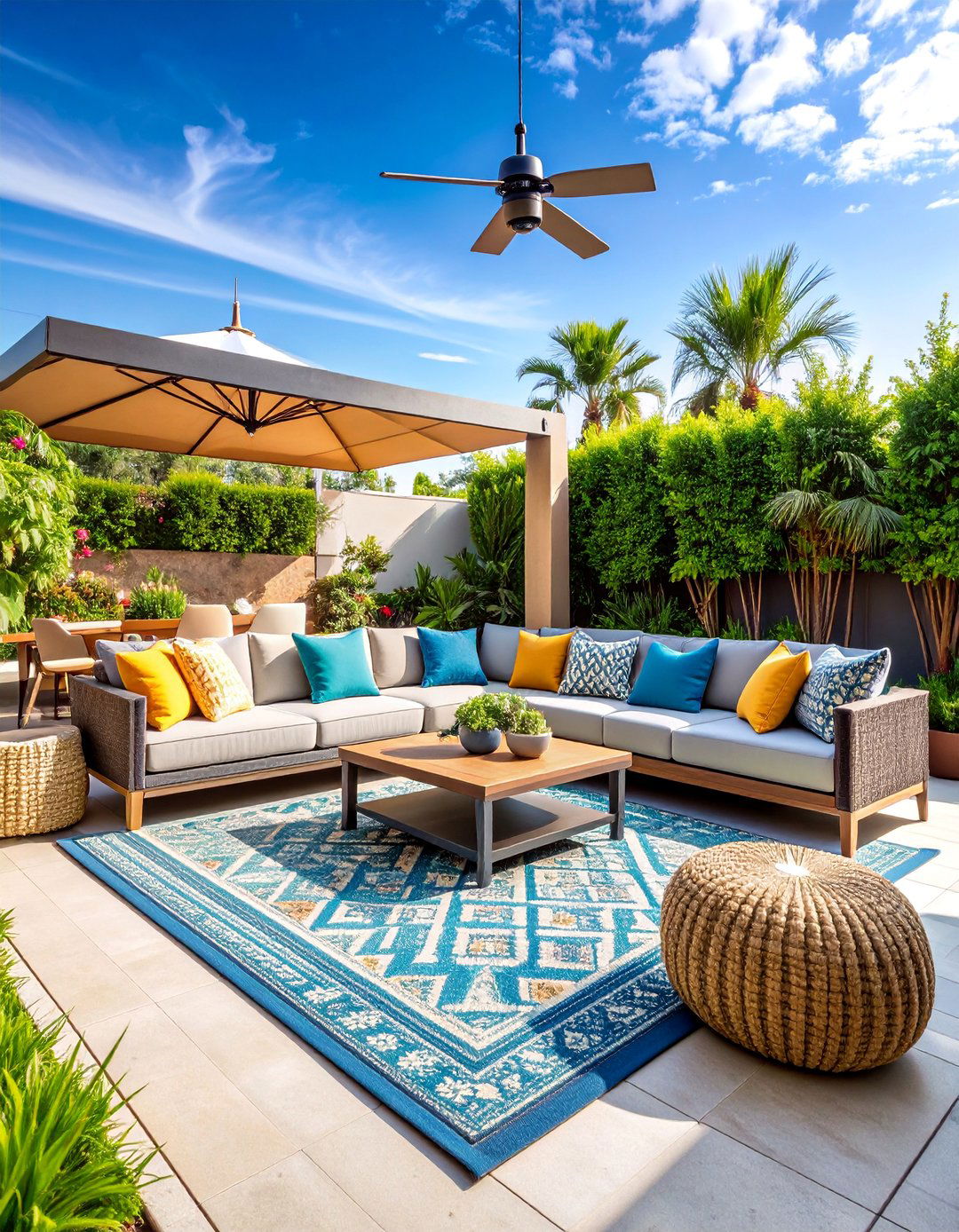
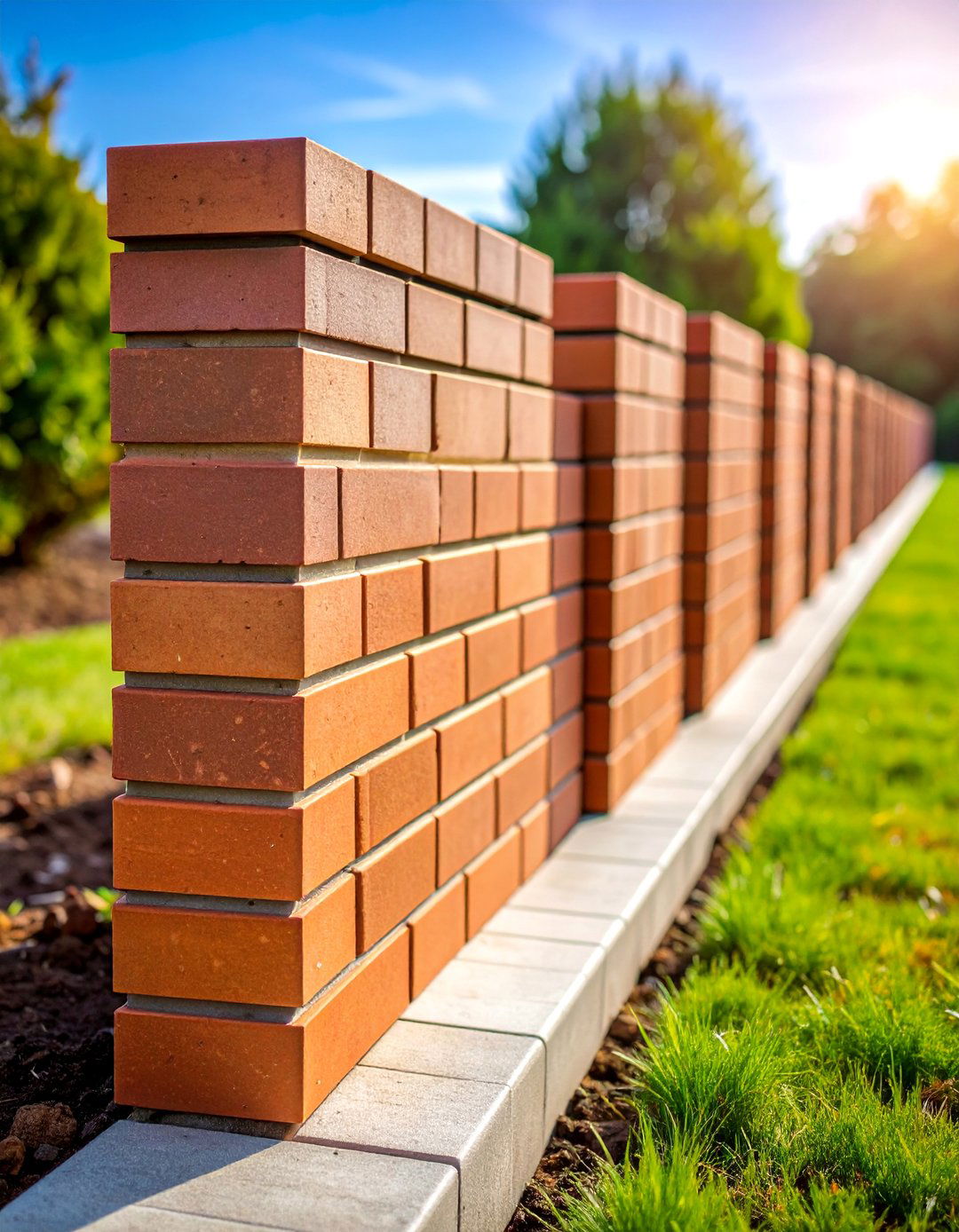
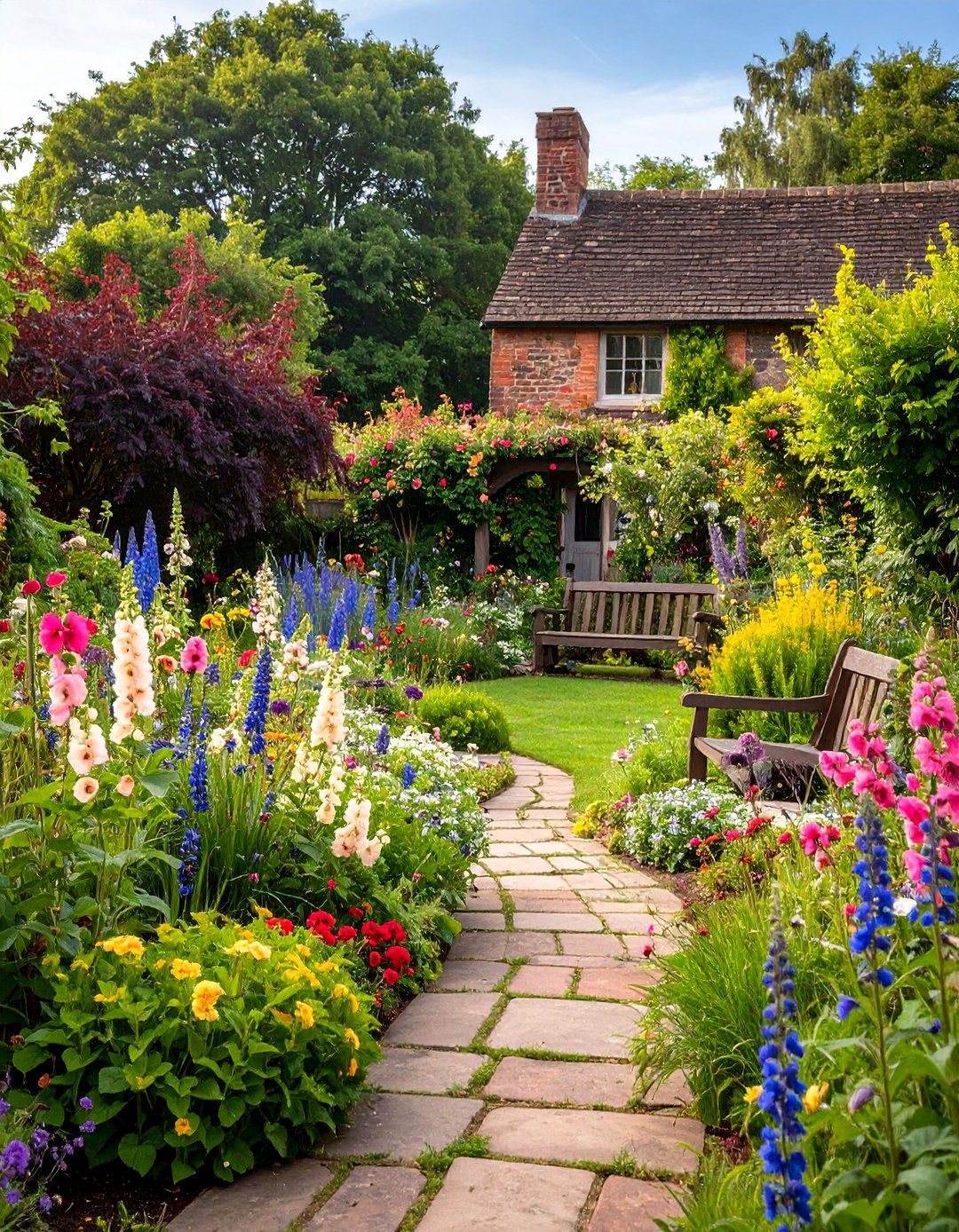
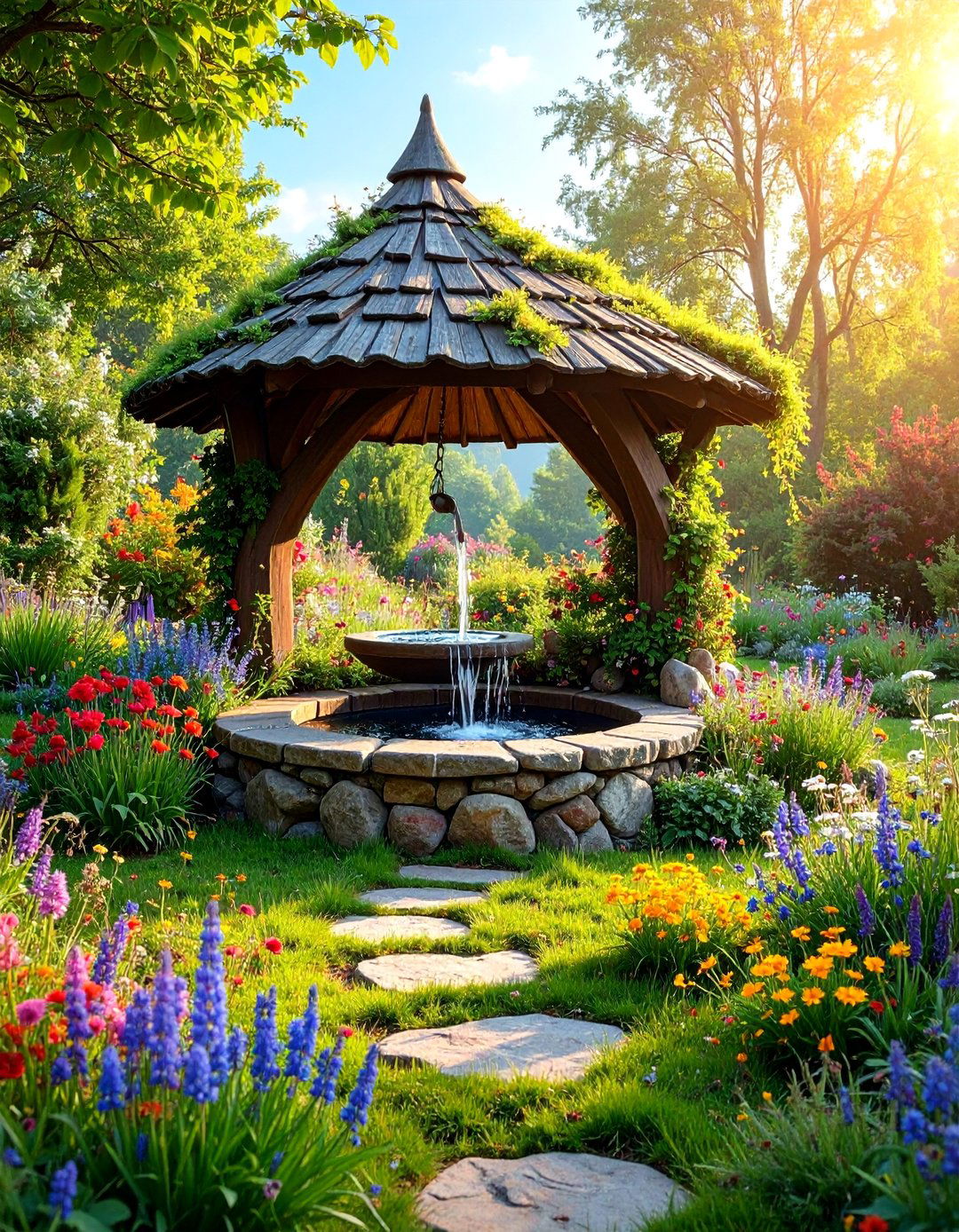
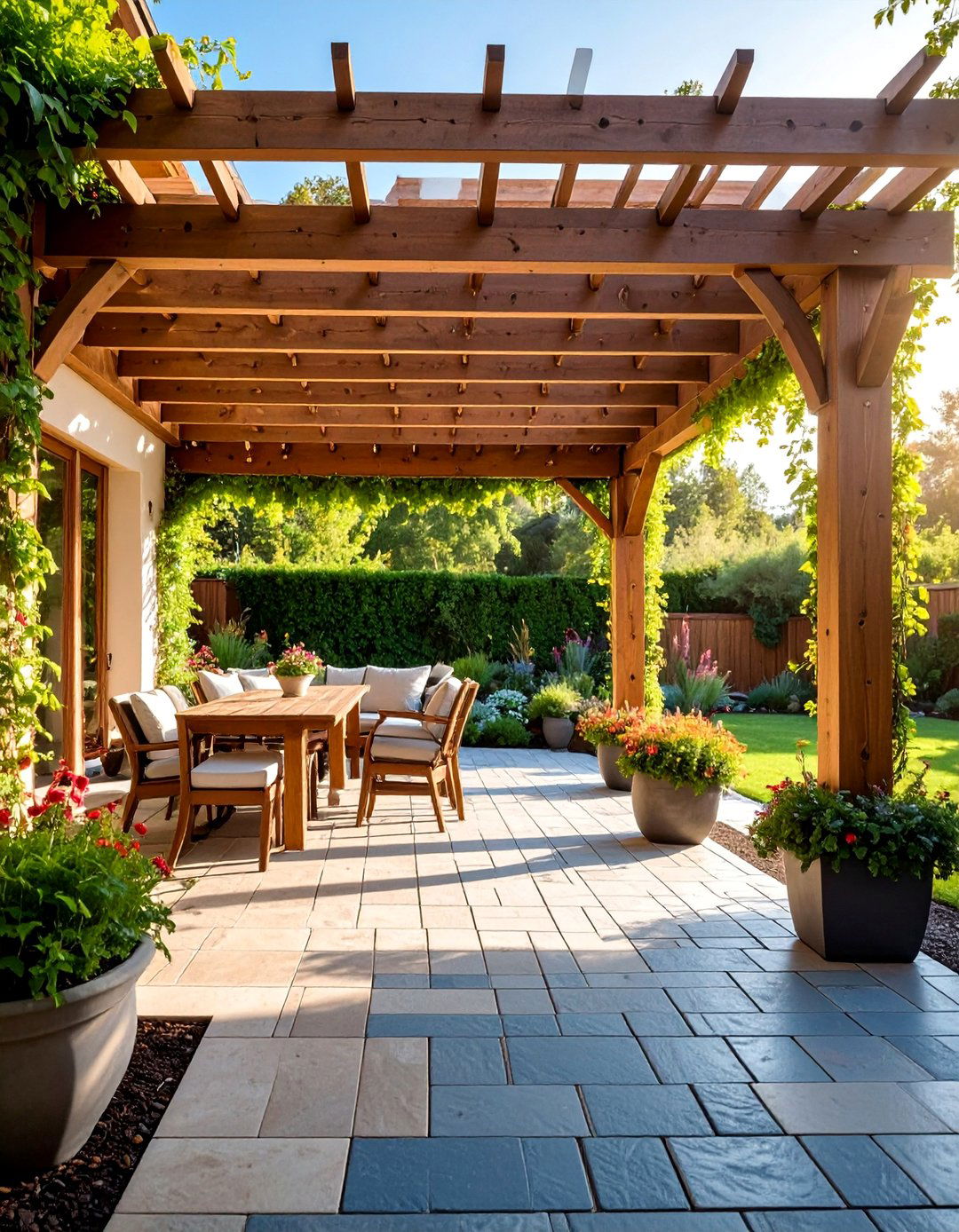


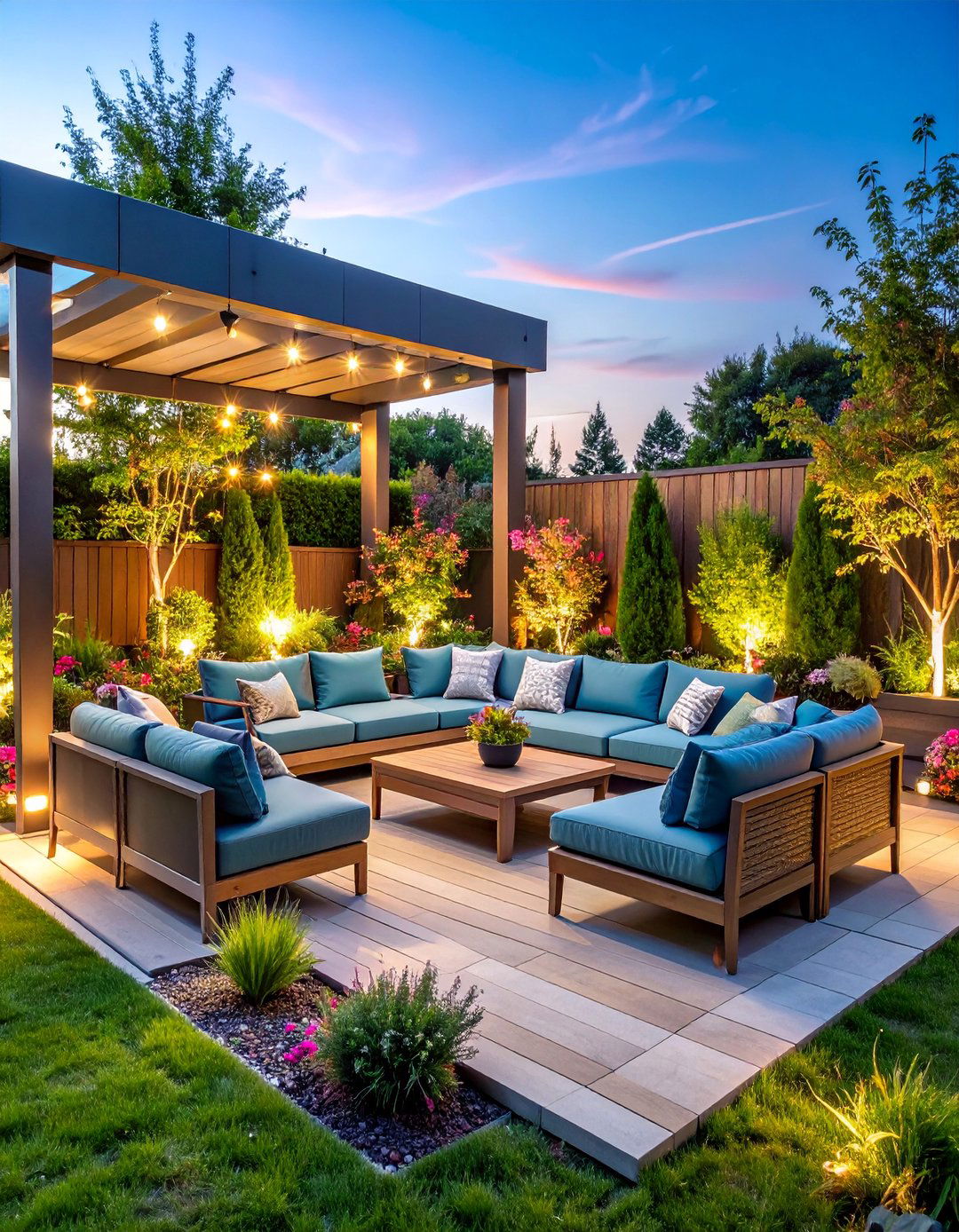
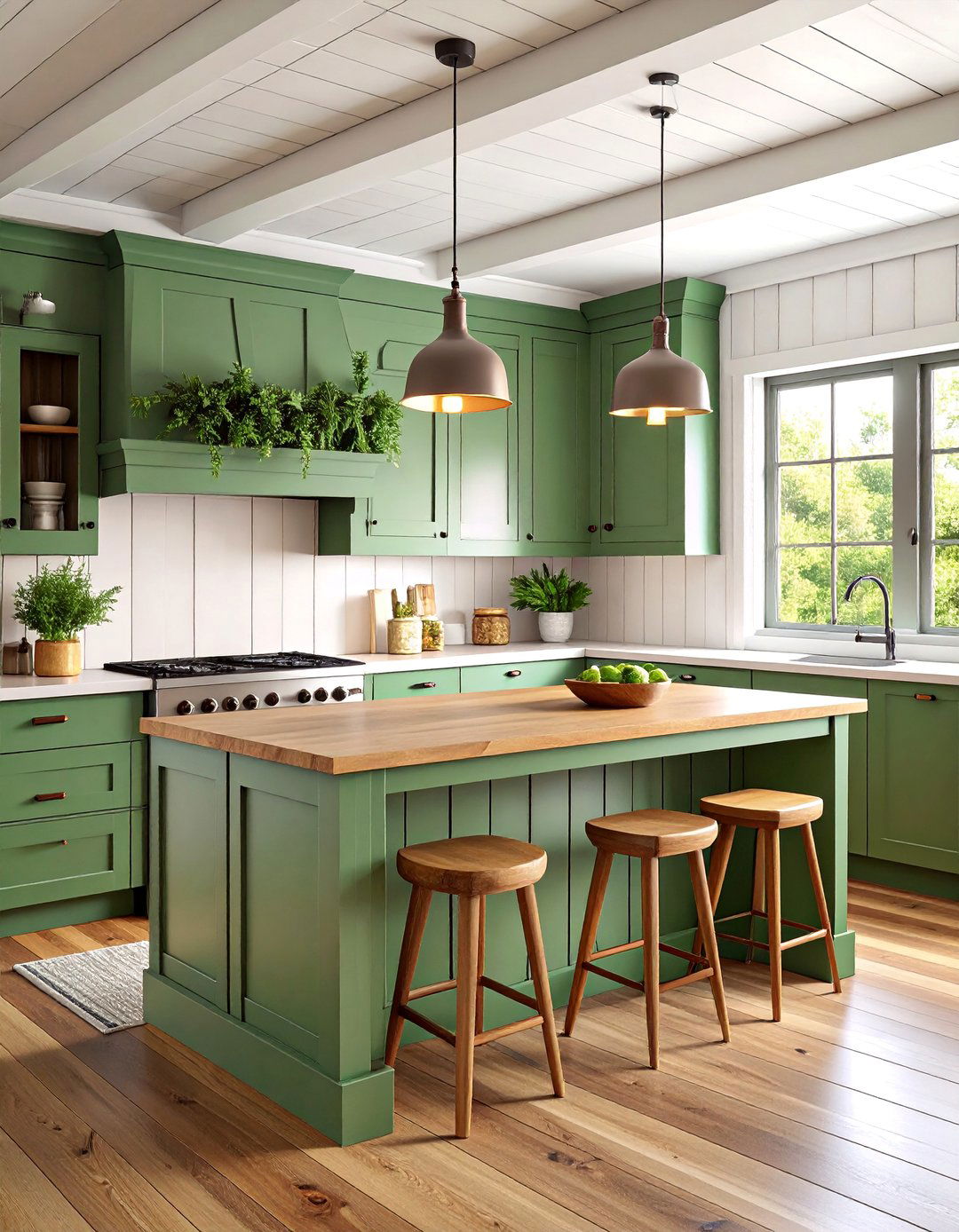
Leave a Reply